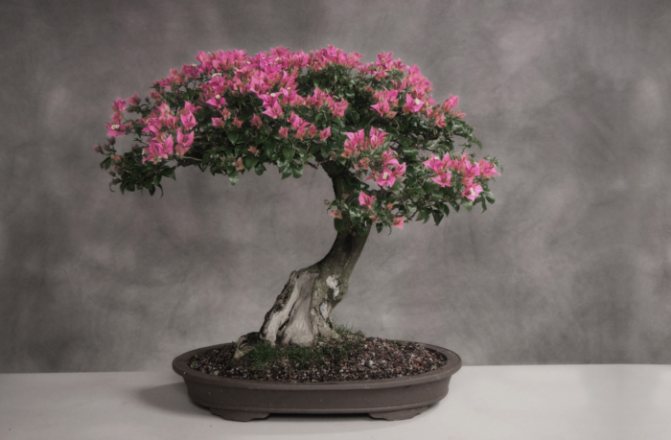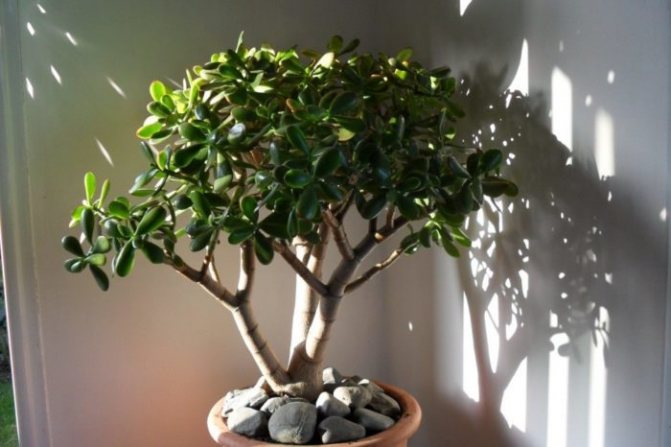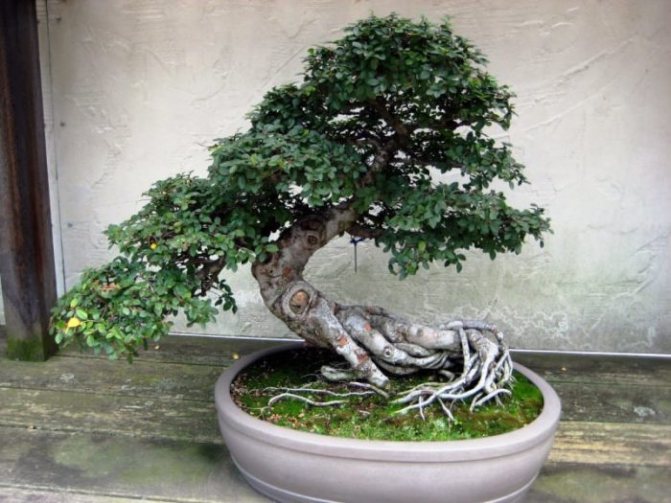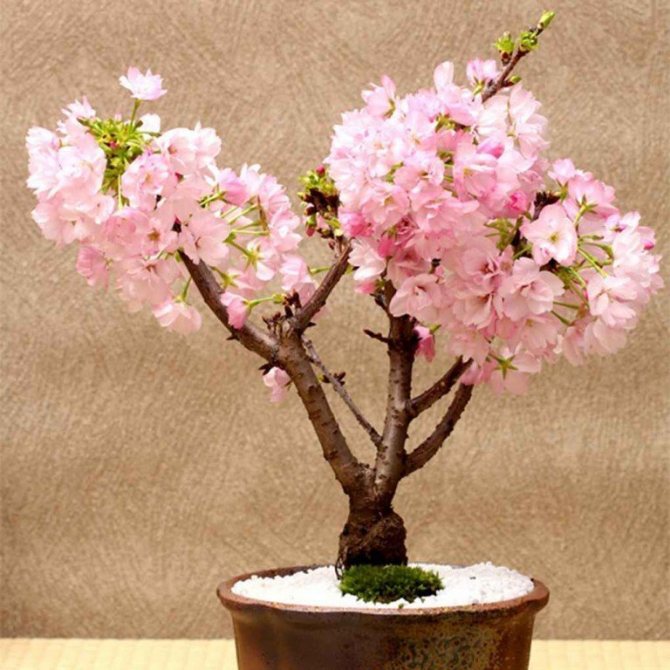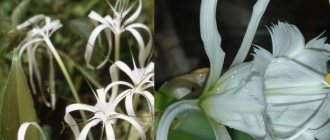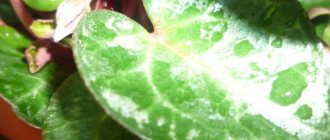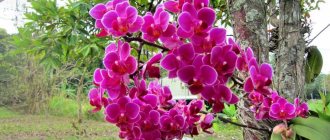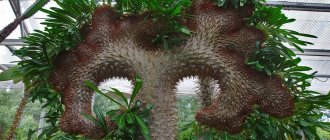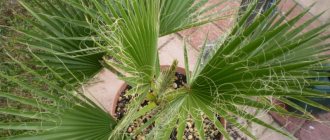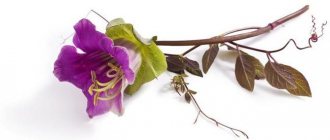Sakura at home: description
What sakura varieties can be grown from seeds
Seed and soil preparation
Which capacity is better to choose
Planting seeds - terms and rules
Sakura in the garden
Japanese sakura is known to everyone. The fabulous plant has been sung many times in various works of art. This cherry is famous for its unique shades of leaves and flowers that delight the eye all year round. Growing sakura used to seem like something impossible - today more and more gardeners boldly take up the cultivation of this plant. And they get great results with due care.
Sakura - description
By origin, sakura is classified as finely sawed cherry. Lovers will be surprised, but this is a tree of the Plum genus, belonging to the Pink family, and its second name is finely sawed bird cherry. The birthplace of sakura is Japan, the Korean Peninsula. It is also found in some parts of China, growing mainly on mountain slopes in mixed forests.
Gardeners appreciate sakura for its amazing beauty during the flowering period, when inflorescences appear on the tree, which, depending on the variety, have a varied palette of shades, ranging from white and pale pink to rich purple.
Sakura is found in Japan with yellow, reddish and even green flowers!
You can grow a tree from a seed (bone) and from a cutting. The best specimens are seedlings from the island of Hokkaido. An important detail is that sakura, sprouted from a seed or cuttings, is planted on a hill, which will have a beneficial effect on its development.
Description and varieties
Sakura has many varieties. Each type of tree and shrub blooms in its own time, passing the baton to the next one along the chain. Thus, nature prolongs the opportunity to admire the seasonal tradition of Japanese spring. The maximum flowering period is about 10 days.
This culture aroused interest among Russian gardeners. Now sakura is grown in many summer cottages. There are enough examples when sakura grows well and blooms in the harsh climate of Siberia. To create varieties of this tree, it is crossed with cherries.
The most common of the sharp-edged cherries are:
- Kikushidare-zakura is a tall, three to five meters tree with large, double, pale pink and cream flowers (up to 6 cm in diameter).
- Shirotae - sakura height about 4.5 meters, non-double flowers, white-cream (more often grown in England and Japan, it is also called "village cherry").
- Kwanzan - has multi-petal purple flowers.
- Hally Tolivett is a cultivar with a spherical crown formed by pink inflorescences about 4 cm in diameter.
- Amonogawa is a tree with pink and fragrant buds, reaching a height of eight meters.
When planting in the open field, always take into account the possibility of adapting cherry blossoms to the natural conditions of the region. Not every species tolerates Russian frosts. But varieties such as Kiku-Shidare and Kanzan thrive on garden plots.
How to grow sakura from seeds at home?
Gardeners for growing at home use only a few varieties of ornamental cherries.This is a rather capricious type of tree, so not all conditions for growth are suitable for it. To increase the survival rate in modern breeding, existing sakura species are crossed so that the new variety is more resistant and adapts faster.
Suitable varieties
Sakura varieties suitable for breeding by hobbyists:
- Spire;
- Shidare Yoshino;
- Halle Olivetti;
- Shirotae;
- Shirofugen;
- Kikushidare;
- Tai Haki.
All of these varieties are resistant to stressful situations and low temperatures. They also reproduce successfully by seeds, not just cuttings. Another plus is a high decorative factor.
How to choose seeds?
- Inspect the seeds. The skin should be firm and firm, but not dry, the surface of the seed - free of cracks and spots. A small cruciform incision can be made in the seed, but the procedure must be performed with extreme caution, otherwise the inner part will be damaged. If you are not sure that you can make a neat cut, it is best to leave the seed as it is. This will slow growth a little, but you will be sure that the strongest seedlings survived;
- The seed is planted immediately after collection, otherwise it will lose its freshness and germination;
- Always sow about one and a half times more seeds than required. Not all of them will ascend, so you need to hedge yourself in advance.;
- Large samples are planted in the ground one by one, small ones - over the entire surface;
- Seedlings are placed in a warm place with diffused light. Direct sunlight should be minimized;
- The seedlings are covered with a film or a glass / plastic lid;
- When the first shoots break through, lift the cover from time to time to bring in fresh air.
Landing conditions: in stages
Of course, it is not worth waiting for the sakura to bloom in a lush color from an ordinary stone, which was simply stuck into the soil and poured with water. Growing this tree requires special care. Competent cultivation includes a set of rules and regulations for the preparation of seeds, soil, planting containers and irrigation / lighting regimes.
Soil preparation
- The preparatory stage before planting is to soak the seeds. They are placed in lukewarm water for a day, while its temperature does not exceed 30 ° C. Experienced gardeners advise to drip a little foundation, granosan or mercuran into a container with soaked seeds to resist fungal diseases. Protecting the future sprout is already at an early stage of development;
- The soil should be composed of coarse sand. Sakura feels most comfortable in it, getting enough moisture and air. The seeds will germinate faster, their germination is guaranteed as much as possible. Before planting, the soil should be disinfected to eliminate pest larvae and pathogenic bacteria;
- Fertilizers are not applied at the sowing stage, since at this stage the seeds will have enough natural concentration of minerals in the soil;
- An obligatory procedure before planting is to moisten the sand, since the seeds will need sufficient moisture to grow.
Sowing sakura seeds
- Make furrows on the surface of the soil with a depth of about 2 - 2.5 cm. The distance between the furrows should not be tight, about three centimeters on each side is enough;
- Spread the seeds into the grooves, screwing them lightly into the soil, at a distance of at least two centimeters from one another;
- Sprinkle sand over the plantings. The thickness of the top layer is equal to twice the diameter of the seed.
More tips for planting cherry blossoms
- When choosing a container for laying soil and sowing seeds, keep in mind that it must be wide enough so that the development and growth of seedlings are unimpeded;
- The optimal depth of the container or plastic cup / pot is at least five cm. It must have drainage holes in the bottom, which guarantees balanced circulation of water in the soil to saturate the root system with the required amount of moisture;
- After the seeds have sprout and the sprouts have been strengthened, the container will need to be changed to a more durable and spacious one. If you plan to grow sakura bonsai, the new pot, on the contrary, should be cramped. For garden planting, you need a deep and wide tub.
- Sakura seeds are usually planted in spring, late summer or early fall.In any case, it must coincide in cyclicity with the biological rhythms of the plant's vegetation. Only then is a quality result guaranteed.
If at the germination stage you devote enough time to planting and follow all the instructions, the future tree will be healthier and stronger.
Care and watering
Sakura is not the most tenacious plant. A draft, an excess of direct exposure to ultraviolet radiation, a sharp change in temperature and an incorrect irrigation regime can destroy a growing seedling. Do not allow the soil to dry out: the root system should develop without stress, so that the seedling is stronger and stays in the soil as stable as possible. When planting in season, the volume of the required liquid per day per container up to 5 cm deep is half a faceted glass (100 ml); in the winter season, watering is carried out less frequently.
The sakura variety determines the type of top dressing applied. Nitrogen and potash fertilizers are standard choices. With a deficiency of nutrients in the soil, the deficiency can be supplemented by regular application of humus.
Additional care tips:
- For proper care of the plant, sanitary pruning is carried out, preferably, it should be done before the spring movement of tree sap begins in the trunk;
- Sakura should not be sprayed during flowering: it can kill pollinating bees;
- So that the tree is not infected with aphids, its trunk is treated with petroleum jelly, which prevents the movement of carrier ants.
Open ground transplant
After two years, the seedlings are transferred to open ground. Conditions for transplanting sakura into open ground:
- The diameter of the bore is 35 - 40 centimeters, the depth is about half a meter.
- Do not forget to fill the bottom with a drainage layer of pebbles, gravel, small stones or expanded clay.
- You can mix the type of drain you have with a little charcoal.
- The ground backfilled needs to be separated from the debris of branches, extraneous roots, etc.
- The pit is filled up to half with it, after which a seedling is planted and covered with the remaining soil mixed with humus, river sand and field soil.
- After strengthening the cherry blossoms in the hole, trample the ground near the planting circle, water it abundantly and add the top layer.
- It is necessary to make a watering circle near the trunk. If the latter is too thin, drive a peg into the soil and make a retaining post out of it.
The planted tree needs no less careful care. It is also regularly watered, the trunk is covered for the winter, weak branches are cut off and top dressing is applied. When properly handled, sakura will delight you with its first fragrant flowers as early as three years after sowing the seeds. Flowering period is approximately seven days every spring.
Landing
Bonsai seeds can germinate for several years, however, proper planting will be the key to obtaining a beautiful and healthy culture. Work on rooting a culture in a pot is best carried out in the summer months, as a rule, the planting material, previously rooted in the sand, will already be fully prepared for transplantation. As practice shows, in summer, seeds will begin to form roots much faster, so the culture will develop faster.
The pot is filled with prepared soil; you should not fill the container to the very top. It is necessary to leave about 3 centimeters, at this level the processed seeds are laid out, which must be well pressed with a piece of wood. Then they are sprinkled with the remaining earth, which is recommended to be tamped well. Some growers additionally cover the pot with polyethylene, making several holes in it for air flow.
When shoots appear, the covering material is removed, and the pot is placed in a bright and warm place in the room.

Work related to the care of miniature crops is reduced to regular moistening of the soil and airing, the soil in the pot should always be moist. To avoid root rot, which is a fairly common problem due to the small size of the pot, flower growers water in several ways. In the first case, it can be irrigation of the crop with water. For these purposes, it is recommended to use rainwater, which needs to settle for 2-3 days before watering. Moisten the tree from a special teapot. The second option is to immerse the pot in a large container filled with water. The culture should be in it for about 2-3 minutes.
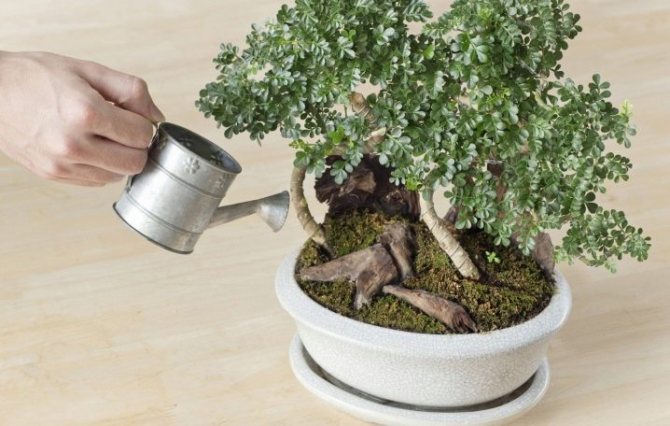

Before sprouting, the pot should stand in a shaded place, at an air temperature of about +16 C. With the appearance of sprouts, plants will need sunlight for growth, then it is recommended for bonsai to maintain room temperature. When the sprouts are 2-3 months old, the florist will need to dive the trees. This is necessary to stimulate crops for further growth and development.
Bonsai maintenance also involves additional plant nutrition, especially in summer. For these purposes, it is recommended to use complex store formulas, adding them to the pot in small portions.
During the formation of the crown, it is necessary to fertilize the bonsai 2 times a month, and algae-based fertilizing should also be applied monthly.
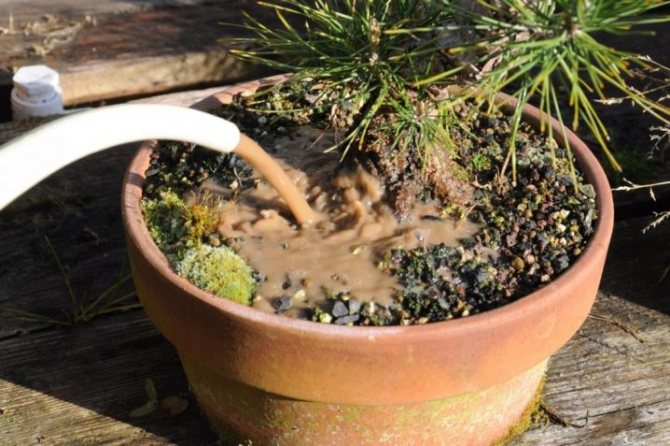

For the health and growth of miniature crops, phosphorus, potassium and nitrogen are very important. The latter is necessary for the productive growth of green mass. Phosphorus is responsible for the growth and division of plant cells, including the root, and it also has a beneficial effect on the immunity of crops. Potassium will help plants fight bacteria and microorganisms, in addition, the trace element will promote flowering of plants. When placing a pot with a culture indoors, you should avoid direct sunlight on young trees. Ultraviolet light can provoke a burn and lead to the death of the plant.
The main task of the grower in the process of growing miniature trees is the process of re-rooting. The essence of this important work is to shorten the root shaft by two-thirds. In order to enhance the growth of the rhizome, some crops are given hormonal injection. Typically, the plant will be ready for such manipulations at the age of 3 months. Culture shaping begins when the tree reaches several years.
How to grow bonsai from seeds, see the next video.
Sakura: planting and care at home
Subcategories
Sakura - refers to the tree-like representatives of the plant world from the genus Plum. Japan is considered the true homeland of this tree; it is in this country that there is a massive sakura bloom in the spring, which so attracts tourists. The flower of the plant has a variety of color shades, from white to dark pink. It is on these grounds that cherry blossoms are distributed by type. Homemade Japanese sakura is a separate plant variety that is able to grow and reproduce in our climatic conditions.
Many landscape designers increasingly began to introduce the planting of this particular plant into their projects, because its beauty will not disregard even the most inconspicuous area. Every gardener wants to have this extraordinary cherry in his garden or in the country. Since it is quite difficult to grow a full-fledged homemade sakura from seeds, most people resort to buying ready-made plants. But it is worth noting that Japanese sakura, grown with one's own hands from seeds in ordinary home conditions, is not a myth, but a reality.In order to fulfill your fantasies or simply surprise your neighbors with a beautiful tree on the balcony of an apartment, first of all, you need to know the basic rules for growing sakura directly at home.
What sakura varieties can be grown from seeds
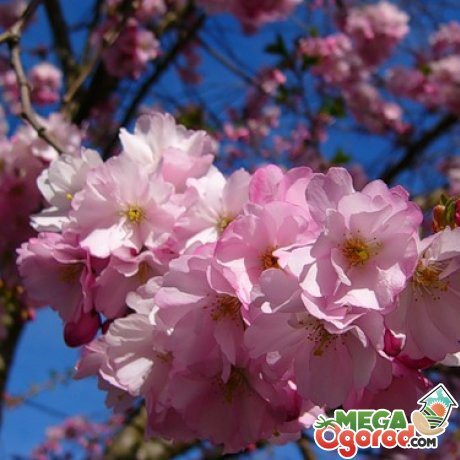

Several types of the famous cherry are used in horticulture. If you have a desire to grow cherries yourself, then you should carefully choose the variety. Each variety has its own characteristics and rules for growing and care.
Today, careful selection of cherry blossom species leads to the emergence of new varieties that adapt to certain conditions.
Modern species are usually created by crossing various already known species. This creates plants with the desired characteristics and more resistant to various growing conditions. It is this approach that allows you to open sakura for gardeners. For crossing, they often use the Yedoensis cherry, as well as Initise, Lannesiana. The result is the Spire, Shidare Yoshino varieties, which are distinguished by delicate shades of petals and resistance to frost up to minus 30 degrees.
Halle Olivetti is also intended for growing in regions where severe frost is possible. The plant reproduces well and allows you to form a spectacular site design.
For growing sakura at home, experts recommend choosing from the following varieties: Amanogawa, Shirofugen, Shirotae, Tai Haku. These varieties perfectly tolerate stressful situations and actively reproduce by seeds. This will help you to become better acquainted with Japanese plants and gain practical skills in working with them. Sakura of these species has a spectacular appearance and fully corresponds to the ideas about this tree.
Preparing to grow sakura from seeds at home
First of all, it should be noted that the method of growing sakura from mature seeds directly at home has its positive aspects:
- no need to spend money on the purchase of plant seedlings:
- sakura takes root well, as from the very beginning it adapts to certain environmental conditions.
At minimal cost, it is sakura, as an extraordinary tree grown at home, that will become an unsurpassed decoration of a living room or loggia. Growing beautiful sakura from seeds at home involves the use of such varieties: Amanogawa, Shirofugen, Shirotae, Tai Haku.
The most important point in the cultivation of plants, the origin of which is foreign in nature, is to adhere to all the basic rules for planting and care from leading botanists and breeders. First of all, you need to know how to properly plant Japanese sakura seeds for growing at home.
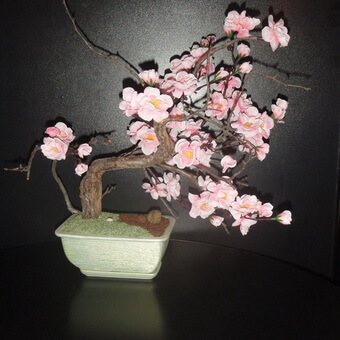

The preparation of planting material involves the following steps:
- the seeds are carefully examined before planting and only whole intact healthy bones are selected;
- a day before planting the seeds, pour water at room temperature with a small amount of manganese or a certain fungicide.
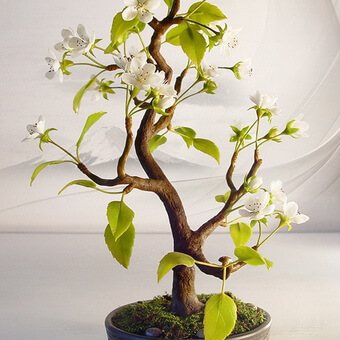

Important: the so-called process of soaking and disinfection is a very important point, since it is quite difficult to grow healthy sakura in certain home conditions. Therefore, it is necessary to exclude all possible variants of fungal or mold damage to a young, unprotected plant.
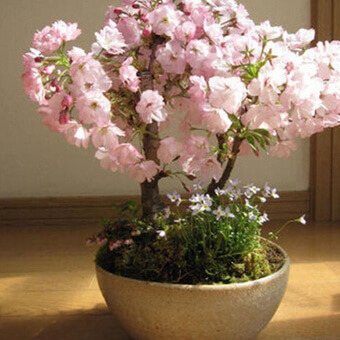

The frequency of planting plays a fairly significant role; it is best to plant sakura from seeds in early spring or early autumn. This will allow the plant to enter the right growing cycle and grow healthy and beautiful. To achieve visible results and get a healthy plant, you must adhere to the rules for planting seeds and seedlings.
Processing and germination
Before rooting tree seeds, a number of preparatory measures should be taken with purchased or hand-picked material.It is possible to germinate a culture only after mandatory processing. Summer will be the optimal time for seed rooting, which means that preparations for planting should be done in advance in spring or autumn. In order to plant healthy plants, experienced growers stratify the seeds. This method allows you to recreate winter conditions for seeds that will temper young crops. There are several options for stratification of planting material.
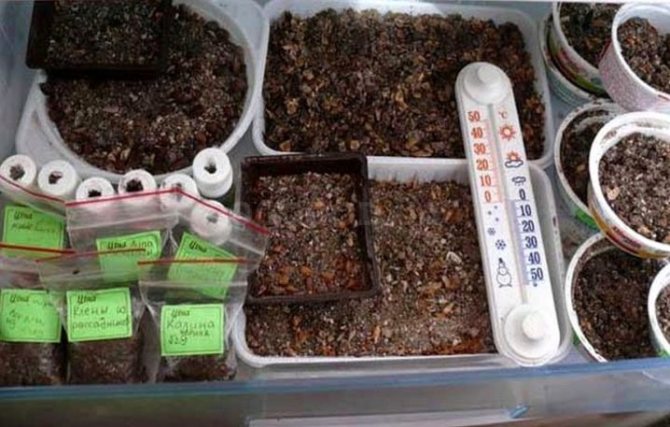

Cold way
This treatment will be needed for planting material, which still needs to ripen before rooting. This applies to thuja, spruce and pine. The essence of the method is to soak the specimens in water at room temperature, followed by keeping in the refrigerator. Such manipulations artificially create a sharp temperature drop, which often occurs in natural conditions.
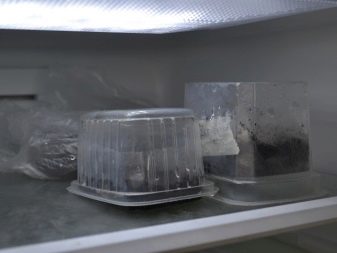

Warm stratification
A more gentle treatment, the purpose of which is to awaken the plants. In order for the seeds to hatch faster, they are placed for a while in a container with warm water or in a humid environment.
How to properly plant sakura seeds at home
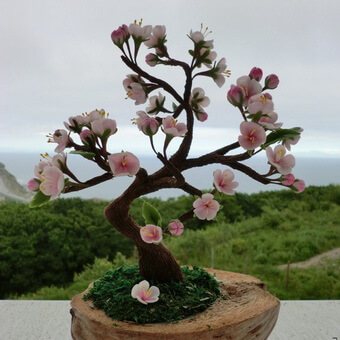

- for planting, seeds are used, collected from the plant after the flowers have dried, the storage time of the planting material should not exceed 1 year;
- it is necessary to plant 2 times more seeds than the plants need, since there is a certain percentage of seedlings ascending;
- be sure to provide protection from direct sunlight;
- adhere to the planting interval between seeds: for large seeds it is 5-7 cm, for small ones 2-3 cm.
Observing the rules and using high-quality planting material, in a couple of months it will be possible to see young sprouts, which will eventually need to be transplanted to a specific place on the site. Sakura, like a wonderful home flower, will feel great on the balcony.
Regardless of the variety and selection, sakura for normal growth and development of the tree-like body and the further formation of flowers requires planting in a certain soil. That is why, when preparing for planting, it is necessary to take into account the fact of the plant's predisposition to coarse-grained sandy soil, it is such a soil that must be used.
First of all, you need to disinfect the soil, this can be done with the help of special preparations or, directly, by roasting in the oven. Thus, they kill all unnecessary bacteria and fungi that can harm both seeds and young plants.
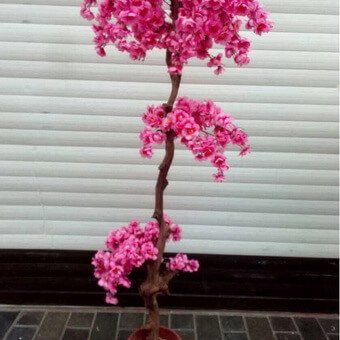

The second very important point is the choice of container for disembarkation. Depending on the desired number of shoots and taking into account the interval between planting, you should take a container of the appropriate length.
For example: for 6 large bones, a container with a length of at least 30 centimeters is required.
It should be borne in mind that in the early stages of development, the root system of sakura is fibrous, the depth of the container should be from 5 to 10 cm.
The container is filled with soil on?, It is necessary to have a pallet and drainage holes at the bottom, for air circulation and drinks with moisture. At the bottom of the flowerpot, you need to put pebbles or small pebbles.
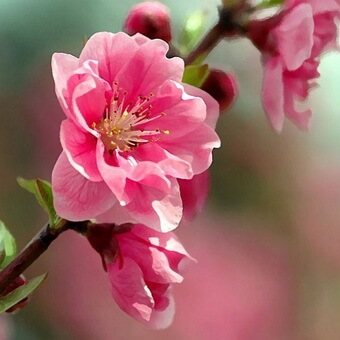

Planting Japanese cherry blossoms from seeds at home, involves the use of compact plastic containers specially designed for growing seedlings. Such containers will fit very compactly on a windowsill or on a cabinet.
Planting seeds:
- sowing of seeds is carried out in soil with a moisture content of at least 60%;
- the bones must be immersed to a depth of 1-2 centimeters;
- from above, the container must be closed with polyethylene to maximize moisture conservation and create a certain atmosphere;
- watering is carried out every 2-3 days, before the ascent, water in an unpaved way, after - only with a pallet;
- 2 months after climbing, the plant can be transplanted into another container for single growth.
From 6 to 9 months old, sakura can be planted outdoors.
Selection of soil and pot
To grow a beautiful bonsai on your own, you should carefully select not only the material for planting, but also choose the right pot. Seeds should first be germinated in small peat cups, several crops for the composition can be rooted in a flowerpot with drainage. Today bonsai is grown in pots, which can vary not only in shape but also in depth.
Miniature crops look equally beautiful in oval, rectangular or round containers. The containers can be deep or flat. When choosing a pot, it is necessary to be guided not only by personal taste preferences, but also by the rules for placing plants. Trees that will grow with a slope need a stable container to keep the pot from falling over. The best option would be deep containers made from heavy raw materials.
The color design of the bonsai pot can be any, the external attractiveness of a dwarf plant can be emphasized by bright colors and calm monochromatic products.
The design of the container will be more correctly selected depending on the style of the live composition in it. Bushy trees will look great in flat and wide containers. Cascade crops are usually grown in narrow and tall flowerpots. Regardless of the color and shape, before rooting plants in a container, it should be disinfected by treating it with boiling water, which will kill bacteria and fungi, if any, on the material.
For miniature crops, it is also necessary to pick up the soil. As a rule, growers will root the sprouted seeds in a special potting soil mixture designed for bonsai. It is not often sold in gardening shops and is called "akadama". The soil is rich in nutrients and therefore very heavy. In addition, the soil is distinguished by a high level of humidity, as well as excellent aeration. Pure soil is used very rarely.
Often, the soil for miniature trees is prepared independently by mixing a nutrient substrate with granular clay, sand and humus. The proportions are selected depending on the type of plant being grown. Based on the varieties of crops, the soil can be as follows:
- for deciduous trees: 7 parts of turf, 3 parts of sand;
- conifers: 4 parts of sand and 6 parts of sod soil;
- flowering miniatures: 7 parts of turf, 3 parts of sand and 1 part of humus.
In addition to collecting planting material for bonsai on your own, you can also make the soil for it yourself. Sod land is easy to find in a meadow, taking for your needs land from the middle layer, which will be more suitable for culture. Before use, it must be cleaned of residues of other plants and weeds, and also sieved through a sieve. As for the rest of the components for preparing the substrate, coarse-grain sand will be needed, since it will provide the earth with proper air circulation, and will also allow it to retain moisture for a long time. Humus is sold at any flower shop. Before using the resulting soil mixture, it must be disinfected by calcining. For these purposes, you can use a kitchen oven.
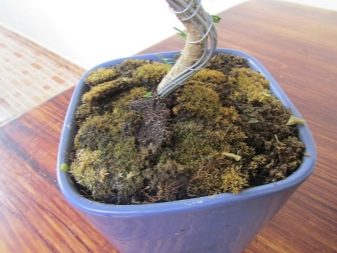

Top dressing of sakura from a seed at home and a photo of flowers
It is worth knowing that at the time of germination, young ears use nutrients from their own cotyledons, therefore, fertilizing during planting is excluded, since this can provoke the development of fungi or oversaturate the soil with organic matter, which as a result will slow down, rather than enhance the growth and development of the plant.


Nutrient feeding is carried out in a pallet way, when the tree has reached a height of at least 5 cm, it was at this time that the root system was formed, is able to function correctly, and requires additional nutrients.
It is necessary to take into account the fact that sakura requires constant care when growing at home, this concerns, first of all, feeding with organic fertilizers in the period before flowering or on time. No fertilization is required before entering dormancy.
The state of true dormancy corresponds to the seasonality and vegetation of the plant, that is, with the onset of autumn and winter, the sakura seems to fall asleep in order to renew its strength until next spring.
You can see how homemade sakura is grown on the balcony in the photo:
Watering, feeding, wintering
The main problem with caring for a bonsai is watering it. Due to the small size of the pots, the roots of the tree deform and the efficiency from watering is reduced. There are two main methods of watering: irrigation and immersion.
- The plant is watered with water from a special teapot.
- The pot with the tree is placed in a bowl of water and taken out after a few minutes.
It is better to water it with rainwater, if it is not there, let it stand for two days with tap water.
Remember, bonsai dies without water. Even if its leaves are green, but there was no watering for a long time, the roots are most likely dead.
In the summer, watering should be done more often and more water should be poured.
Top dressing is important when growing bonsai, especially at the time of crown formation. The tree is fertilized once every 2-3 weeks, and once a month it is necessary to apply fertilizer based on algae. The most important fertilizer components are potassium, nitrogen and phosphorus.
Nitrogen is responsible for the growth and development of the leaves and stem of the tree. It is a major component in promoting cell division and protein production.
Phosphorus stimulates cell division, is responsible for budding and has a positive effect on the growth and development of the root. Protects against disease.
Potassium helps fight disease-causing microorganisms and promotes fruiting and flower development.
These substances must be present in bonsai food. In flower shops, it is difficult to find a suitable option that contains all the substances in the required proportions. Therefore, we recommend mixing fertilizers yourself in the following proportions:
- in spring, when the growth period is more intense, apply more nitrogen. The optimal ratio of nitrogen, phosphorus and potassium is 12: 6: 6, respectively;
- in summer, food should be more balanced, so the components are added in equal proportions - 10:10:10
- in autumn, less nitrogen is required, the optimal ratio of components is 3 parts of nitrogen and 9 parts of phosphorus and potassium.
If the bonsai is grown from a flowering tree, focus on adding potassium in a proportional ratio of 12: 6: 6
Indoor bonsai plants are fertilized all year round, and outdoor plants are fertilized from early spring to mid autumn. Young trees are fertilized every 2 weeks, older bonsai can be fed every 4-6 weeks. Blooming bonsai should not be fed during and immediately after flowering. When feeding, remember that it is better to apply less fertilizer than "overfeed" the plant.


At the onset of winter, inexperienced gardeners who have miniature trees on the street make a huge mistake - they bring them into a warm room. This behavior makes the tree grow constantly, it takes too much energy and depletes resources. Having deprived the plant of its natural "rest", all efforts can be wasted. A tree that grows on the street needs to be properly prepared for wintering:
- Clean branches from dirt and pests.
- Move the trees to an elevated, well-lit, draft-free location in the garden.
- At temperatures below -10 0 C, transfer the plant to an unheated room.
- Make sure that the soil is not too wet.
Bonsai is an amazing art and painstaking work that begins with the selection and search for seeds and never ends. Like all living things, bonsai requires care and thanks its owner for the kindness with green leaves, bizarre shapes and unique sophistication of the image.
To consolidate the material, watch a good video on growing bonsai from seeds. The author has a lot to learn!
Did you like the article? Share it with your friends on social networks by clicking on the desired button below.
A wonderful miniature of a garden tree in our house or greenhouse. Growing bonsai at home is easy if desired. The only thing that will be required is patience, especially when growing large quantities of bonsai.


Seeds and types of popular miniature trees
Among the bonsai species, some of them have gained particular popularity. Most often, the following species are grown from seeds:
- tropical: boxwood, acacia, wisteria, leptospermum, ficus;
- broadleaf: beeches, birches, hornbeams, elms, maples;
- conifers: cedars, spruces, pines, firs, cypresses.
In fact, the list of available woody plants is much longer. For example, seeds: spruce, euonymus, pine, beech, oak and fir can be planted at the time of harvest.
Bonsai seeds can be found on their own in parks, groves, and so on. It's much more fun than shopping at a store. But you will need special knowledge, from searching to preparing and growing seedlings.
Amateur gardener tips
An important point - in the period up to 3 months, it is necessary to carry out the formation of seedlings.
If you find seeds, but want to plant them at a different moment, then you will need to properly save the material. To do this, they must be placed in a container or, better, in a special wooden cellar. Before this, the seeds should be dried. They should be stored in a cool room at temperatures from -5 to 0 degrees Celsius.
Sakura bonsai grown from seeds at home
Sakura bonsai, grown from seeds in ordinary home conditions, will ideally fit into the interior of a house or apartment. Bonsai should be grown in wide, shallow containers to prevent root overgrowth. During the growth period, when the plant has reached at least 25-30 centimeters, you can start forming the crown. To do this, it is necessary to cut the main pagon so that the tree develops a crown in width. Unusual crowns can be made by tying the growing pagons with wire to create a specific look.
Important: it is quite difficult to grow a sakura tree in the open field from seeds in a home summer cottage; it is best to use seedlings for further planting on the site.
Planting of seedlings is carried out in the fall, the age of the seedlings should be at least 6 months, and preferably more. The older the seedling, the more resistant it is to environmental factors. Very young seedlings will have to be wrapped up for the winter with the arrival of frost, so as not to lose the plant.
Planting rules are identical to growing from seeds, any kind of soil must be mixed with sand for maximum germination of the sprout. Do not forget about fertilization and watering, and periodically drain the soil around the tree to improve air exchange in the root system. Proper care of sakura does not take much time, the most important thing is to do everything clearly and according to the rules, and the efforts made will give an unsurpassed result.
After homemade sakura surprises with its first flowers, it will be possible to collect seeds and give advice to friends, recommendations on how to properly grow Japanese cherries with your own hands.
Check out the homemade cherry blossoms in the photo below:
Soil and container for growing bonsai
The best soil for seeds is considered to be coarse sand, which is steamed before use. This is a kind of disinfection that will prevent the plant from dying.It is recommended to use a wide container with a depth of 5 cm and drainage holes. Before planting, the sand must be well moistened and special grooves must be made in which the seeds will be placed.
To grow bonsai at home, you should take care of preparing the soil and choosing the right container. The container in which the miniature tree is grown can be of different shapes and depths. Rectangle, oval, circle or polyhedron, deep or flat - the choice is really big. Remember, if the trunk of the bonsai has a slope, then the container for it should be more stable. In this case, give preference to deep containers or those made of heavy material.


The colors of the container should be calm and discreet, this will only emphasize the elegance of the plant. Moreover, the bowl should match the bonsai style. If the miniature copy will have a dense crown, then it is better to choose a flat and wide container. For a cascading style bonsai, a narrow and tall pot is suitable, and the tall crowns of the plant will better emphasize the containers that are deep, but not wide.
Scald the bowl with boiling water before planting to eliminate possible sources of fungus and bacteria.
Traditionally, bonsai is grown in a special substrate called akadama. It is a heavy soil, rich in nutrients, high moisture levels and good air circulation. However, such land is rarely used in its pure form. Firstly, it is in its pure form only in one of the prefectures of Japan, and secondly, a high concentrate of nutrients does not always have a beneficial effect on bonsai, especially during the period when the tree is being shaped.
Bonsai substrate must meet several criteria: it retains moisture well, contains nutrients and provides oxygen access to prevent souring or decay of the roots. A good substrate is mixed from granular clay, humus and sand, in the ratio that suits each type of plant.
- Type of wood and soil used.
- Deciduous trees. Sod land and sand, in a ratio of 7 to 3 (3 parts sand and 7 parts turf).
- Blooming bonsai. The mixture is prepared from turf, sand and humus, in a ratio of 7: 3: 1. Coniferous bonsai. Four pieces of sand and 6 pieces of turf land.
You can prepare the soil yourself at home. Sod land can be dug up in a meadow. One has only to remove the top vegetation layer, and the top 20 centimeters of soil can be used to grow bonsai.


Before use, the land must be cleaned by sifting through a large sated. The sand should be taken from the river, coarse-grained. It will make the soil looser, which will improve air circulation, and it holds moisture better. Before use, all these components should be disinfected by heating in the oven. Humus should be purchased in a specialized store or ordered via the Internet.
Sakura from seeds: preparation for planting
The basis for growing any crop is high-quality seed. Sakura seeds can be purchased at specialized retail outlets. Seed germination is poor - no more than 20%. On this score, gardeners advise:
- buy more stuff;
- use products from different manufacturers to determine who has the best quality.
The process of planting a tree requires the following actions:
- Stratify. For seeds, simulate natural winter weather. To do this, put them in a bag of wet sand and place them in the warmest compartment of the refrigerator. At a temperature of + 4 ... + 5 ° C, the material should be stored for at least 2-3 months.
- A couple of days before planting, soak the seeds for a day in lukewarm water.
- To help the seedlings break through the seed coat, mechanically scratch or puncture the outer layer.
Sakura seeds are planted in coarse sand that has been calcined or otherwise disinfected.Such a substrate is most suitable for germinating seeds and, in addition, will protect the culture from diseases. An alternative to sand is moss or vermiculite. Use a wide, shallow container as a pot. Drainage holes are required.
Seed and soil preparation


You can't just take seeds and place them in the soil - you will not get the expected result. For the competent cultivation of sakura, compliance with certain rules and regulations will be required, including for the preparation of the soil and the seeds themselves.
During the period of working with sakura, gardeners have developed certain rules:
- Before directly planting seeds in the soil, place them in warm water for 24 hours. The temperature should be 25-30 degrees. During soaking, it is recommended to add some fungicide to the water, which contributes to an effective fight against fungal diseases. This is a serious threat to the development of the plant, therefore it is important to protect the tree at the earliest stage, when it is most vulnerable.
- At the stage of sowing seeds, fertilizers can be omitted - natural minerals in the soil and accumulated in the seed are quite enough at the first stage of growth.
- The sand is abundantly moistened before planting - for rapid growth, a large amount of moisture will be required. Special grooves of shallow depth are made in the sand, into which the seeds are placed. The distance between the seeding strips should not be less than 3 centimeters - plants can interfere with each other and limit themselves in development.
The best option for sakura soil is coarse sand. So cherry seeds germinate quite quickly and guarantee good results. To accelerate growth, the seed coat can be punctured to facilitate germination of the sprouts. Be sure to disinfect the soil - this way you will eliminate possible organisms developing here and protect the seeds from damage by pests.
Read also: Harm of tobacco to the body
After placing the seeds in the soil, they are sprinkled with sand for additional protection and creating conditions for development. The top layer should be no more than double the diameter of the seed.
How to plant and dive sakura at home
Correct planting is half the success of the future sakura cultivation:
- treat the seeds with a fungicide;
- moisten the substrate;
- deepen the seeds by half a centimeter into the grooves made (there should be at least 3 cm between them);
- cover the planting with a thin layer of fine sand;
- cover the pot with foil or glass;
- leave at a temperature of + 5 ... 10 ° C.
Attention! Gardeners recommend planting seeds in the spring or at the turn of August and September.
Seedlings should appear in 1.5-2 weeks. Up to this point, care consists in maintaining the top layer of the soil in a moist state, providing a large amount of light, and gradually raising the temperature to room level. Shoots appeared - dive them into separate pots. The distance between the planted seedlings should not be more than 10 cm if you are moving them to a new common container.
A pick is an important condition for the normal development of sakura. Multiple transplants strengthen the root system. Sakura seedlings are not touched only in the cold season. They are placed in a cool, shaded room until spring. The key point in picking up grown seedlings is the selection of new pots. The gardener has two options:
- leave the culture to grow in a cramped container and form a bonsai version of the tree;
- move it to deeper and wider pots and prepare the tree for the garden.
Departure Point: Cherry Pit
A luxurious overseas guest is capricious and whimsical in cultivation, but, nevertheless, is increasingly found in our gardens, parks, city squares.
As befits a cherry, a Japanese beauty grows from a cherry fruit seed.The long journey of turning a small cherry seed into an adult tree is not the easiest, but the end result is worth the effort and time. It starts, of course, with the purchase of planting material.
If you have an adult fruiting Japanese cherry in your field of vision (from friends or in your own household), you can stock up on seeds from it by collecting ripe fruits and freeing the seeds from the shell. Another option is to purchase ready-made seeds from an online store.
Read also: Cherry Magaleb antipka growing from seeds
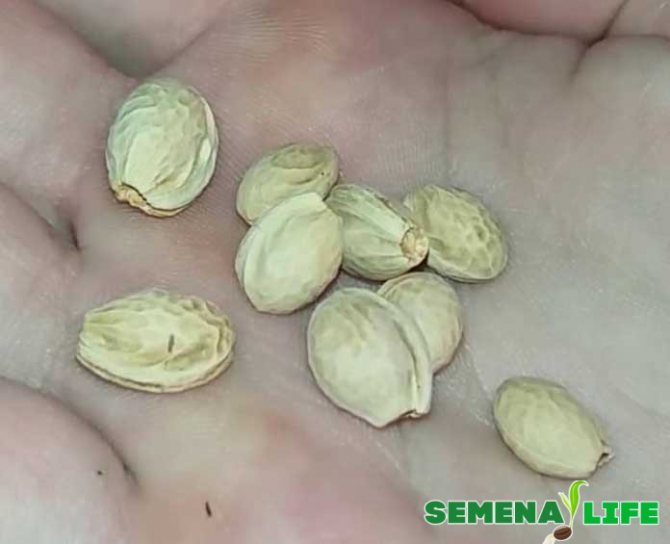

Sakura seeds
The species diversity of cherry blossoms is quite large, while not all varieties take root in the Russian climate. Our winters tolerate such sakura varieties without any problems:
- Kikushidare - 3-5 meter double-flowered tree
- Kwanzan - with large purple flowers
- Spire and Shidare Yoshino are specially bred frost-resistant varieties that can withstand temperatures down to -30 degrees
- Halle Olivetti - also frost-resistant species
Thanks to the selection and breeding of new varieties, today there are frequent cases of successful cultivation of sakura even in Siberia.
Before planting in the soil, the seeds should be soaked in warm (30 degrees) water for a day. It would be nice to add fungicides or growth stimulants to the liquid - additional protection for capricious fruits will not be superfluous. The outer shell of cherry seeds is very hard, therefore, to facilitate germination, you need to carefully prick or cut the shell, but in no case damage the inner part.


On a note! Sakura seeds do not germinate well, so they need to be planted "with a margin", taking into account potential losses (even only 20% germination of the material is considered the norm).
After soaking for a day, the bones are ready for further procedures.
Planting and picking seedlings
Sakura loves slightly acidic loose soils, the ideal option is coarse sand. You can dilute it slightly with compost, wood ash. The soil, in order to avoid seedling diseases, must be calcined.
The container for disembarkation must be shallow, always with drainage holes. The seeds are buried in the sand by about a centimeter, with a three-centimeter distance between them. On top, you can pour a half-centimeter layer of fine sand, and cover the container with foil.
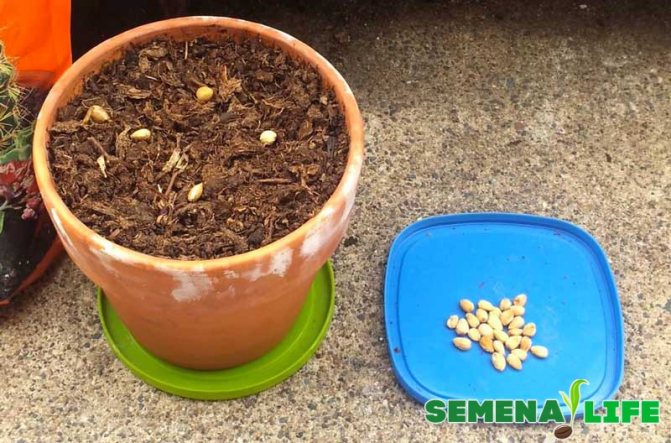

The answer to your question: the best time to plant seedlings is spring (after the last frost) and late summer - early autumn.
Then the planted seeds undergo cold stratification: the temperature should be 2-4 degrees, the period should be two months. The bottom shelf of the refrigerator is considered the best option. Two months later, the box with seeds must be taken out, and then the seedlings must be germinated in room conditions. It is necessary to monitor the constant moisture content of the soil and a sufficient amount of indirect sunlight. Seedlings usually appear in one and a half to two weeks. With the emergence of seedlings, you can slightly raise the film so that more fresh air comes in.


Sprouted seedlings are immediately planted in separate pots or in a larger common dish, leaving a 10-centimeter distance between the shoots. The pick "trains" the root system, so the seedlings are transplanted annually - in spring and autumn, excluding the winter period. With each transplant, plants need to pick up more spacious pots and apply humus to the soil (or feed them with special fertilizers from April to September).
Destination: a place in the garden
Two-year-old seedlings are ready for planting in open ground. To do this, a planting hole is dug with a diameter of about 35-40 cm, a depth of 40 cm. Drainage is poured at the bottom (pebbles, crushed stone, etc.), the earth from the hole is carefully separated from stones, roots, and the like, and covered with drainage up to half the height. The seedling itself is planted in a mixture of humus, compost, sand and field soil.
Planting rules are standard for all tree seedlings: trample the ground, water, fill up the top layer, make a watering ditch around the trunk. The thin stem must be attached to the retaining post.
The planted trees still require careful maintenance: they need to be watered, avoiding overflow, weeding, loosen the top soil layer, wrap them up for the winter. In the spring, when flowers and leaves are formed, nitrogen-potassium feeding is required.
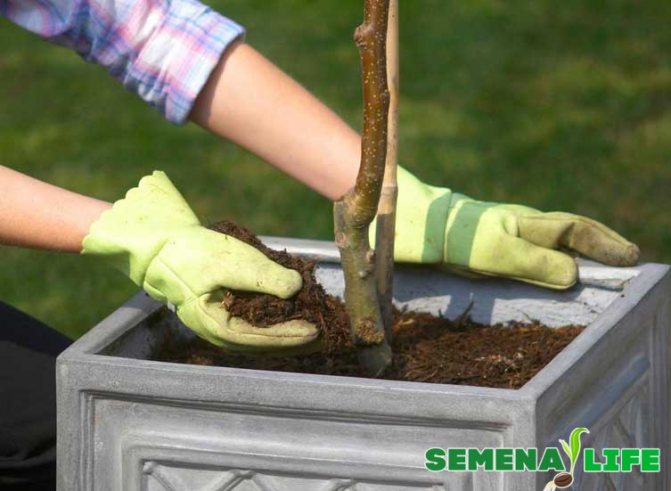

After only 3-4 years after planting seeds in pots, the young sakura in the garden will already delight with annual flowering, continuing to grow. An adult tree blooms with bright and fragrant flowers for about a week every spring, in autumn the sakura is also picturesque - the foliage acquires a yellow-purple hue.
Sakura is the common name for certain types of cherry trees. Their harvest is meager, but during flowering the plants amaze with their beauty. A guest from Japan can be grown from seeds in the conditions of domestic gardens. A home tree can be the size of an ordinary sakura or be a copy of it several tens of centimeters high. Gardeners share their experience, photo and video recommendations on how to avoid mistakes and successfully go through the long-term path of growing a tree.
Features of tree care
Sakura varieties have many differences in cultivation techniques. To grow sakura bonsai, the roots are shortened every season, and horizontal cuts are made on the bark, right on the trunk. For a garden tree, these methods are irrelevant - in the room you form a seedling, and then transplant it into open ground.
The rules for caring for a particular species are different. A common feature is that trees are moody and require daily attention. The tree needs soil enriched with humus, potassium, nitrogen. During the season, sakura is watered with half a glass a day, in winter - less often. Good lighting and the absence of drafts are important for the plant.
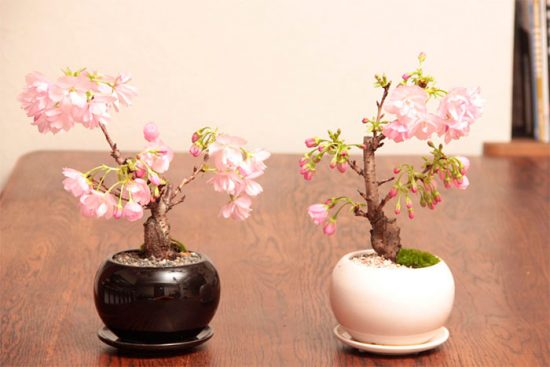

The secret of the beauty of sakura is not only in the large and abundant flowers, but also in the aristocratic crown. It can be formed starting at the age of 2-3 years of the plant. In natural and miniature versions, the branches are ordered according to the same pattern. Crohn can mean a straight trunk, a bend in the spirit of the age-old Japanese cherry blossoms, or widely spread branches.
Growing techniques and styles
This art comes from China, for the first time such work was undertaken by order of the emperor, who wished to recreate the miniatures of his empire not only in the form of buildings, but also trees. According to the religious beliefs of Buddhists, a master who was able to create small copies of plant cultures was equated with a deity. Today, a number of techniques and styles are used, focusing on which, the masters work on the creation of bonsai. Two cultivation techniques are considered the main ones: traditional and special.
Traditional
She, in turn, allows gardeners plant crops in the following styles:
- straight trunk;
- informal straight;
- style, assuming the presence of two barrels;
- cascade and half-cascade;
- bonsai with a protruding rhizome;
- oblique and literary;
- group composition;
- broom style.
Special
To germinate crops, adhering to the principles of a special technique, is preferred by true connoisseurs and professionals who specialize in creating miniature copies of plants. The styles used in this direction can be as follows:
- "Common roots";
- bonsai of forest form;
- scenery;
- growing on the rock and in the wind.
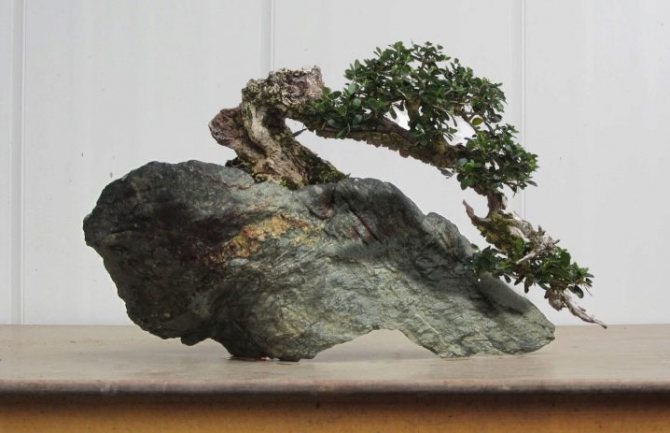

How to properly prune bonsai sakura
To grow a miniature culture, experts use various tricks and techniques. The task is to make even a young tree look like a hundred-year-old tree. For this:
- Expose some of the roots by removing a small layer at the base of the trunk. He must be fat. To do this, regularly remove all vertically growing shoots.
- The barrel should not be too long. Cut off a portion of the root at its base. When replanting, deepen the cut into the ground. Over time, new roots will grow on it.Then the tree can be dived again, while removing the old rhizome.
- The most massive branch of the tree will be the bottom one. What kind of escape to leave for its formation - decide on the basis of the compositional idea.
- For a broom-shaped crown, cut vertically growing branches to the maximum. For vertical, on the contrary, protect vertical branches. In this case, only horizontal ones are cut.
All these manipulations are needed by the bonsai tree constantly. Otherwise, it will lose its shape. The gardener's goal is to maximize the decorative effect of sakura. If you adhere to the cultivation technology, provide the plant with a little care and attention every day, then the Japanese guest will delight you with a lush, large and bright color every spring.
Planting seedlings
The selection and preparation of a planting site for cherry blossoms is considered essential in this process. And if the plant is planted taking into account all the requirements, then the garden will soon sparkle with its natural colors.
When planting sakura in the country, you need to take into account that:
- a cherry tree needs a lot of sunlight, does not tolerate waterlogging, therefore it is recommended to plant it in more elevated areas;
- sakura does not like strong winds, so it needs protection with a fence or other trees;
- the soil under the sakura should be fertile, fertilized with a mixture of humus and potassium phosphate;
- planting pits are prepared 0.5 m wide and 0.4 m deep with a distance of 1.5 m from each other;
- at the bottom of the holes, drainage from pebbles or rubble is arranged.
It is important to carefully select fertilizers.
Sakura does not like soil with high acidity.
Japanese cherries are planted in early spring, after the last frost, or in autumn - in October. The right decision is to purchase one-year-old seedlings about 70 cm in height. They should not have dry branches and wounds.
Landing Algorithm:
- Planted in the center in a strictly vertical position.
- The soil is carefully poured and carefully, but carefully tamped.
- A support is installed and the tree is tied up.
- After planting, the soil is watered and mulched.
Upon completion of planting, experienced gardeners recommend digging a ditch around the perimeter of the hole 10 cm deep and filling it with water. At the first stages of growth, the tree requires a lot of moisture, and when it finally takes root, it will no longer need artificial watering. During the period of bud formation, it is necessary to regularly loosen the soil near the trunk.
Japanese cherries grow rapidly, up to 60 cm per year. At the first signs of spring, even young trees bloom.
Bonsai sakura: description
Bonsai Japanese sakura is a tree that is adapted for life in the house. Seeds are hard to find and subsequently difficult to grow, but with care, everything is quite simple: for the plant to grow properly, direct sunlight and mandatory daily watering are necessary. Growing Japanese cherry blossom bonsai from seeds requires perseverance and patience, and then the bonsai tree will grow beautiful and healthy.
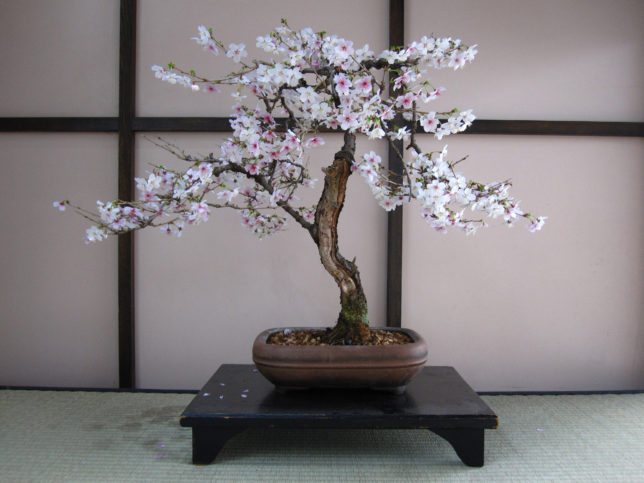

In appearance, Sakura Bonsai is very beautiful from the trunk to the flowers. The trunk of the tree is most often curved, rushes upward, at will. The bonsai itself can reach a height of 8 centimeters, and the most impressive dimensions are limited to 130 centimeters. Small cherry flowers can be not only bright pink, as it is originally in nature, but also have other shades.
Which tree seeds are suitable?
Japanese compositions with dwarf crops can be created with almost any tree plant that will suit the taste of the customer or the gardener himself. Since bonsai has been grown all over the world for quite some time, there is a whole list of the most popular crops, the cultivation of which in miniature allows you to create beautiful compositions.
Among exotic tree-like plants, it is worth highlighting acacia, wisteria, various types of ficuses, as well as myrtle and boxwood.
Russian flower growers very often use apple, birch, maple, Japanese cedar. It will be possible to germinate bonsai from seeds at home if you use planting material from conifers in the composition, for example, spruce, pine, including Pinus parviflora, cypress. Such cultures in a dwarf form can organically fit into any interior. For some crops, there are guidelines for their size:
- acacia, wisteria, pine - 100-130 centimeters;
- linden, ash, beech and oak - 60-100 centimeters;
- maple, birch, hazel - 20-30 centimeters;
- juniper, spruce, irga - 10-20 centimeters.


Planting material is recommended to be purchased only in specialized stores or nurseries, so that the upcoming work will bring the desired result. However, buying seeds is not the only option to create your own bonsai. Very often, flower growers collect seeds in parks or botanical gardens, where a lot of beautiful and healthy plant specimens grow.
Japanese sakura bonsai - growing from seed
Growing sakura bonsai from seeds at home is difficult and not always successful. In most cases, only a few seeds are suitable for growing, and the rest simply will not grow into a real tree. That is why it is better to purchase several packs of seeds, in this way you can increase the chance of sprouting. But you shouldn't throw away seeds that haven't sprouted! It is better to leave them for the next year to try to grow a new tree.
How to Grow Japanese Bonsai from Sakura Seeds
To do this, you need to find sakura seeds. They are usually sold in special stores, more often in online stores, especially foreign ones. Further, the process is as follows:
- To make seeds for better germination in the ground.
- In advance, a day before, dip the seeds in warm water.
- Moisten the soil before sowing seeds.
- Place all seeds 0.5-1 centimeters into the ground.
Then a new period begins, the seeds must go through a simulated natural winter season:
- Cover the container with the seeds with foil.
- Put the container in the refrigerator for 2 months.
- After that, continue to grow seeds at room temperature, in direct sunlight, watering every day.
Seedling care must also be present. Thus, the first sprouts from seeds should be provided with sufficient fresh air. Already at the first leaves, the seedlings can be opened completely, giving the plant freedom and wider access to oxygen. In case of problems, you can consult with people on the forums, and before buying seeds - with the seller. For proper care, you need to buy all the necessary tools in advance, after consulting with the consultants in the store.
Read about the fertilizer Fulvogumate Ivan Ovsinsky in this article.
Seed stratification as a measure of preparation for sowing
There are seeds that are specially prepared before planting - these are sakura seeds. In fact, the Japanese cherry (sakura) is the perfect material for making bonsai. From the seeds of Japanese sakura, you can create real masterpieces that can amaze with amazing shapes. In order for the plant to germinate properly, the seeds of this tree are stratified.
Basically, stratification is a process that simulates winter conditions in order to better germinate seeds. There are several ways to stratify plants:
- Cold stratification. Essential for seeds that need ripening: pine, thuja or blue spruce. The seeds of such plants are first soaked in lukewarm water and then placed in the refrigerator. In this way, an artificial imitation of the temperature drop in nature is made.
- Warm stratification. Used to "awaken" seeds. The planting material is placed in warm water for several hours or days.You can also place the seeds not in liquid, but in an environment with high humidity: wrap with a damp cloth or place in a damp coconut substrate.
- Combined stratification. It is applied to the seeds of maple, cedar, sakura, which germinate for a long time. Its essence lies in the change of cold and warm stratification. Initially, the seeds are placed in a cold room, and immediately before planting they are soaked in warm water. Combined stratification is common in bonsai cultivation.
In addition to stratification, seeds should be disinfected so that the plants are not afraid of the appearance of fungal formations. For this, you can use a manganese solution.


This tool perfectly disinfects seeds before planting. The seed is soaked in pinkish water. Seed disinfection lasts from 5 days to 2 weeks. After the seeds have been stratified and disinfected, they can be planted.
How to care for a small Japanese tree at home
All bonsai are grown in flat pots with a diameter of no more than 20 cm, so that the roots of the tree do not grow. The plant needs to be repotted every year, shortening the root system if necessary. The choice of soil also needs to be approached carefully. Sakura usually grows in soil with nitrogen, potassium and humus. As for fertilizers, everything is also simple: a month before planting, the soil is fertilized. It is best to add fertilizer to the soil in small portions in early summer. When the tree reaches a height of more than 10 centimeters, it is transplanted into a regular flower pot.
Which capacity is better to choose
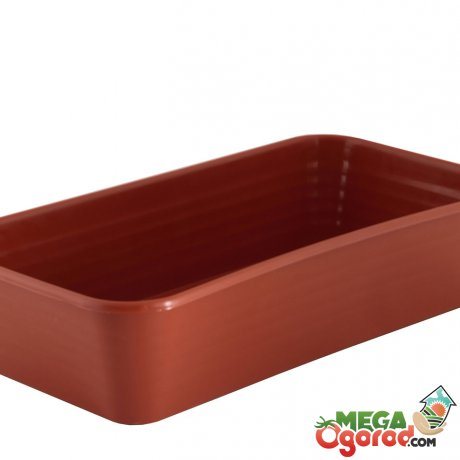

To optimize cultivation, ensure the correct size and parameters of the containers in which the seeds will grow. The container used must be wide enough for the freedom of growth and development of the plant.
The depth should be about 5 centimeters - so the root system at the initial stage of growth will have enough space for active growth. Be sure to make sure that the container has drainage holes, because normal water circulation allows the plant to saturate the elements necessary for development.
How to grow a bonsai from a seedling
Planting material is dug up in a forest belt or bought in a nursery. It is important that the seedling is healthy. Its height should be 15 cm. At the same time, the soil from which it was dug out must be preserved partially. This is especially significant for conifers. The roots are pruned, leaving only 7 cm. The vertical shoots are shortened, the lateral ones are removed. The plant is planted in a substrate and waited for it to take root. At the same time, they monitor the state of the seedling. It is necessary to water it in a timely manner and loosen the ground.


From dwarf forms, you can already get an adult bonsai. This method has advantages. Growing time is dramatically reduced. Minus - decorativeness is significantly reduced. Skeletal branches and lignified trunk are difficult to change. They are difficult to direct in the right direction. The tree is dug up and examined for infestation by pests or infections. Bonsai can only be grown from a healthy specimen. The roots are cleaned of soil and pruned to 7 cm. The plant is planted in a previously prepared container. The main shoot is pinched. After a year, it is required to shorten the roots and twigs, remove excess branches. The procedure is repeated several times. Young branches can be bent easily. They are immediately given the desired shape. This is done with a thin wire.
How to properly water a bonsai
Planting correctly is only the first crucial step on the way to growing a dwarf tree. Next, you should follow the rules of care so that the tree can develop.
In the summer season, the soil is watered several times every 7 days; in the fall and spring, once a week is enough. Make sure that the soil does not dry out. In winter, watering is carried out only a few times.
Coniferous trees are watered once a week during winter because they continue to grow. It is better to water more often with a little water than to flood the plant. This can lead to root rot.


There is such a way of moistening the soil in a pot, such as immersion. For this, water at room temperature is poured into the container. Then a pot is placed in it. Through the drainage holes in the bottom, water penetrates in the right amount into the root system of the tree. After half an hour, the pot can be pulled out.
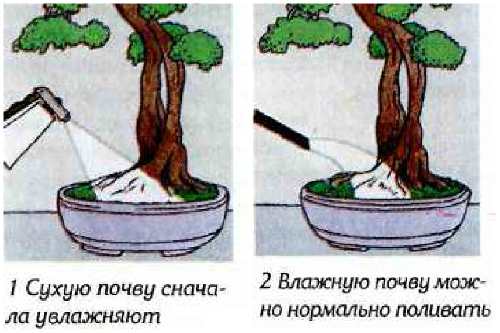

For bonsai trees, not only watering is important, but also spraying, especially in hot weather. For irrigation, you need to use only water at room temperature and settled.
The necessary conditions
Almost every tree can be grown in this way, but you also need to know about the popularity of this or that. So, for example, among the tropical, the most popular are box trees, myrtles, abutilones, leptospermums, acacia, wisteria and, of course, ficuses. Among the broadleaf trees, these are beech, hornbeam, maple, birch, elm, Japanese beech and pomegranate trees. Conifers include fir, cypress, spruce, cedar and pine.
Bonsai seeds can be found in botanical gardens or even in public parks, where beautiful and often unique trees often grow. If you do not have such an opportunity, then you can always buy seeds for growing bonsai at home. This can be done online or in live plant stores locally or on order.
If a grower is just beginning to be interested in bonsai, the easiest way is to purchase a plant already formed, for example, from a ficus or citrus. It will help you master all the techniques of getting away from regular watering to pruning and adjusting the shape of the trunk and branches. The accumulated experience will allow you to move on to more complex tasks.
There are several ways to grow bonsai at home:
- through sowing the seeds of the culture you like and the subsequent "upbringing" of the seedling;
- using a rooted cutting;
- the formation of a seedling from a nursery or wildlife;
- transferring to a pot and correcting an already adult cultivated or wild-growing specimen.
The fastest of these methods is the formation of the crown and root system of a one- or two-year-old seedling. Such a plant already has developed roots, while its ground part gives room for imagination and can be modified according to the plans of the grower.
Enthusiasts who are interested in how to grow bonsai from seeds should know that this path is the longest, but also rewarding. Here, a person has control over the plant literally from the moment the seed spits, and it is easier to change the shape of shoots and roots because of their flexibility.
The seeds of trees and shrubs suitable for bonsai are divided into two types. Some of the crops are immediately ready for germination, but evolution has included a hibernation period in the “program” of many species, when the sprout waits out the cold season. At home, stratification will help simulate winter.
The seeds of trees for Japanese bonsai are placed in wet sand or sphagnum moss for 3-5 months, after which the container is placed in the refrigerator. At a slight positive temperature in a humid environment, the seed prepares for growth. When it is transferred to warmth, the sprout quickly awakens. For evergreen species and plants with seeds that have a particularly strong shell, heat or temperature contrast is used to awaken.
For germination and the first months of life of seedlings, a light sandy-peat substrate or soaked peat tablets that have gained moisture are used. Until a sprout appears on the surface, the container should be in the dark under the film. The air temperature is selected depending on the bonsai tree being grown.
To avoid the formation of condensation and rot, the greenhouse is ventilated. When seedlings appear, they provide a small access of fresh air inside and transfer the seedlings to the light.As necessary, seedlings are watered and fertilized with complex compounds. When the plant reaches a height of 10–12 cm, it is transplanted.
At this stage, the main root is shortened by a third to slow down the vertical growth of the tree. They immediately begin to form the future trunk, for which they use copper wire.
Tropical species
- Krasula,
- Ficus Retuza,
- Portulacaria,
- Wisteria,
- Scheffler,
- Ficus Natasha,
- Ficus Benjamin,
- Ficus Microcarpa,
- Bengal,
- Karika,
- Ginseng,
- Dull,
- Variegated,
- Rusty red.
For tropical plant species, an important condition for growing is the presence of good lighting, humidity, and the air temperature is not lower than 5 degrees above zero.
As a result of growth, Carmona acquires a thick bark, which serves as a delicacy for pests, so it should be periodically treated with a manganese solution. The tree is very sensitive to chemicals, therefore, before processing the plant, a sensitivity test should be carried out on one leaf, wait seven days, if the leaf is not damaged, the chemical can be safely applied.
You need to fertilize a mini tree during the growth period weekly, you should not bother a sick plant or a newly acquired one with feeding.
The optimum temperature for Carmona's growth is at least 12 degrees above zero, with an air humidity above 25 percent. If it is not possible to put Carmona on the south side of the windows, she needs to provide additional light illumination (12 hours).
Before planting, the seeds must go through a stratification process for three months, give preference to black pine seeds, they are less demanding on sunlight. If the seeds are freshly harvested, then they can be sown without treatment.
Seeds are sown in late winter, early spring.
Thuja propagates by cuttings and seeds. Seeds are sown in spring, the duration of growth is from 3 to 5 years! This process is very lengthy, so cuttings are the best way to propagate.
Thuja takes root well in any fertile soil; soil made of clay, sand and lime is used for home cultivation.
It is necessary to contain thuja in a state of partial shade, timely cut, water, fertilize with potassium, phosphorus, nitrogen fertilizers.
Tomatoes on the windowsill, some lovers of this unpretentious vegetable are ready to admire it even in the form of a bonsai, while others even manage to eat the fruits. For bonsai, the Gavrish variety is suitable. Before planting, the seeds are soaked for about three hours in a manganese solution, the seeds are immersed in a container with soil, sprinkled with soil.
In order for the plant to develop well, the lower leaves must be periodically pruned, fed with fertilizers and added additional soil.
Tomato bonsai is an original variety that looks very stylish and bears delicious fruits, it is possible to collect up to 2 kilograms of tomatoes from one bush, each fruit weighing 65 grams, the fruits can be eaten three months after planting.
A miniature tree is miniature for that, so that it can be contemplated in indoor conditions. But there are also exceptions to the rule. Mini saplings are sometimes grown in summer cottages or gardens. To avoid disappointment, select special varieties for such a planting: magnolia, apple tree, oak, Japanese elm, podocarpus and others. Protect the plant from open winds, rain and sun.
To grow a pine tree from seeds will take more time than from a seedling bought or dug out in the forest. However, this allows you to start forming the root system and crown at the early stages of tree growth, which is important for bonsai pine.
To obtain seeds, ripe cones of a coniferous plant are taken and stored in a warm, dry place until the scales disperse. Once this happens, it will be possible to extract the seeds.It is important to use the seed of the current or last year, since the seeds of some conifers do not retain their germination for long.
When the first shoots have broken through, pierce the plastic to provide air access. After the first shoots appear, remove the film from the pots and transfer to a lighted room. Make sure that the plants are not exposed to direct sunlight. After 2-3 months, it is worth cutting off the taproot by 2/3, this process is called the formation of seedlings.
Fertilizers are added to the land where the seedlings ripen. It is necessary to transplant seedlings into a separate form after the sprout has grown by 10 centimeters. During this period, the sprout can be accustomed to the sun's rays and at the same time not stop forming the desired shape.
According to this scheme, you can grow sakura bonsai or Japanese pine. But some types of trees need a special approach.
This tree starts shedding seeds in the fall. To grow bonsai from maple seeds, they need to be stratified for 120 days. The optimal time for disembarkation is April or May. To make sprouts appear faster, the seeds are soaked for 1-2 days in hydrogen peroxide. This measure will speed up the germination process and protect the plant from diseases.
Bonsai from seeds of all types of maple, especially red, must be grown in partial shade - direct sunlight is contraindicated for it. The land for growing this species should be fertilized once a month in order to achieve the desired level of acidity. In winter, feeding is excluded.


Growing a plant from lemon seeds is not difficult. In this case, no stratification is needed. Planting seeds are extracted directly from the fruit. It should be ripe, but not externally damaged. You can plant several seeds at once.
- Prepare the pot and soil as described above.
- At the bottom of the container, make 1-2 cm of drainage.
- Fill to the top with prepared soil.
- Place the lemon seeds 1.5 cm deep.
- Wrap the pot with plastic wrap.
The room where the container with seeds will be stored must be at least 180C. At intervals of 2-3 days, remove the film and slightly moisten the surface with water. Do not overmoisten so that the resulting roots do not rot.
Cedar seeds are the easiest to grow bonsai seeds and are suitable for beginner gardeners. Seed stratification has two stages.
- Lasts 6 days. The seeds are placed in water with a temperature of 25-300C and changed every two days.
- The stratification period is 60 days. The seeds are taken out of the water and mixed with disinfected river sand and peat. This substance with seeds is moistened and mixed periodically until the first shoots hatch.
Once the sprouts have hatched, the seeds can be planted or placed in a container. In this form, cedar seeds can be stored in the refrigerator at a temperature of 20C until they are planted in a pot. Cedar loves a lit place, but does not tolerate direct sunlight.
Common beginner mistakes
Sakura is considered a difficult bonsai to care for. To grow it, it is desirable to have the basic skills of caring for such a crop, obtained by forcing simpler species - myrtle, olive tree, Benjamin's or Microcarp ficuses. Typical mistakes beginner amateurs make:
- excessive watering. Knowing about the dangers of skipping watering, amateurs pour water into the pan, hoping that the plant will take "as much" as needed. As a rule, the tree dies in a week;
- non-observance of temperature and seasonal regimes - feeding in winter and the decision to add lighting with an ordinary lamp. Because of this, in the air, which is already overdried by central heating, the plant suffers more;
- too much wire pulling on the barrel. Crashing into the bark, the wire injures it. The tree suffers such damage painfully.
It should be noted that those who begin to grow capricious bonsai in care cannot do without the death of seedlings.If you analyze the mistakes and learn from what happened, next time it can be avoided.
Japanese sakura bonsai tree: how to grow
Cherry tree bonsai has many names - Japanese cherry, East Asian cherry, sakura, etc. There are nearly 430 varieties, many of which are found in China, Japan and Korea.
Cherries are called sakura in Japan and are widely used in Japanese festivals. There are 200 species that are cultivated in Japan alone. One of the most famous species is Somei Yoshino with almost white flowers on pink legs. They are named after the village of Somei near Tokyo. Almost all plant varieties can be used to grow bonsai. With proper care, you can achieve beautiful miniature trees that bloom and bear fruit like regular cherry blossoms. Museums often exhibit cherry blossoms.


The pink and white flowers are beautifully arranged in bunches of two or five. The leaves grow alternately, and in the fall they turn yellow, turn crimson or red
The trunk of sakura is chestnut in color, slender, dense crown. The tree bears black fruit after flowering and pollination. Sakura care is daily, as the plant is quite capricious.
The winter season for bonsai trees lasts for about three months, during which they are dormant and not growing.
There are several ways to winter bonsai:
- You need to cover the tree with mulch to the lowest branches, shelter it from the wind and sun.
- You can place the tree in a cold and dark place, such as a garage or shed. The bonsai should be watered in winter, but not exposed to light.
In spring and summer, cherry blossoms require sun in the morning and afternoon. It is best to take it out into the garden, balcony or terrace. It is not necessary to keep the bonsai in the room during spring and summer, as it will suffer from lack of sun.
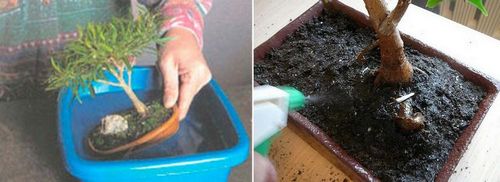

You need to fertilize bonsai every month. Water as soon as the soil dries out, or leave it to rain. It is good when water will pour out through the holes from the bottom. You can also arrange drip irrigation for the plant.
It is best to replant sakura at the end of winter, when the plant has finished blooming. Transplanting will allow the roots to grow in fresh soil.
Sakura can be pruned after the flowers have fallen, new shoots should be pruned but not removed completely.
The birds tend to feed on cherry buds. Caterpillars and aphids also harm the tree.
How long does bonsai grow?
To grow a bonsai-style houseplant, the room must be well ventilated. If weather conditions permit, the flower should be taken out onto the balcony or outside. It is necessary that the moisture level matches the specific needs of the crop. Some plants do well outdoors and indoors. Daily ventilation is required. The exception is winter time. There must be no drafts. The light level should be appropriate for the cultivated plant.
What seeds can I use for growing?
Often, beginners, trying to form a bonsai, immediately target exotic plant species - for example, ficuses. However, art connoisseurs say that a beautiful bonsai can be obtained even from the usual European garden and forest trees. With proper care, they amaze the imagination no less. Plus, their seeds are easier and cheaper to get. Sometimes it is enough to walk in a park or a forest belt adjacent to the city.
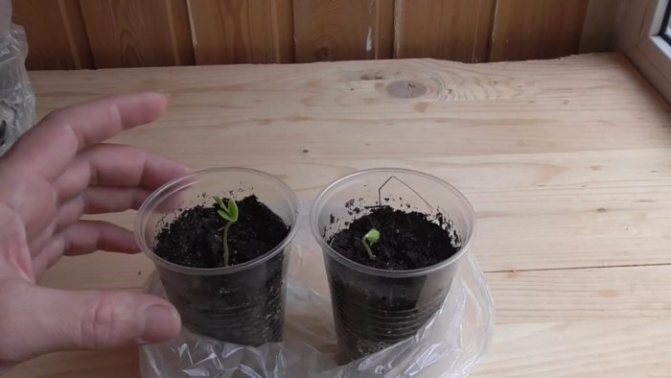

Moreover, not every plant looks beautiful in a reduced copy. For example, the chestnut has large leaves and flowers, which looks bad in a reduced version. But the hawthorn, inconspicuous in nature, is more suitable for this purpose.
Therefore, when choosing breeds, one must take into account the following factors:
- the possibility of branching from old wood;
- leaf size;
- crown density;
- the possibility of growing in small dishes;
- aesthetics of the root shape of the trunk.
Pine
Conifers are convenient because their trunks can be formed without fear of damage. The unpretentious pine tree is an ideal “test of the pen” for beginners.
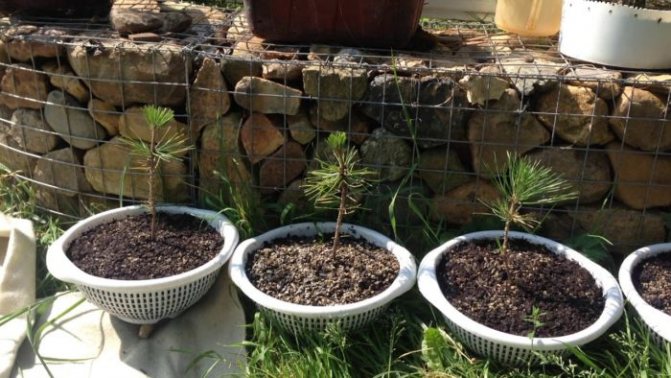

The following breeds are considered the favorites of florists:
- Japanese black is a traditional variety for the Land of the Rising Sun, where it is most often used. This pine tree grows slowly, is unpretentious and has an expressive bark pattern;
- Japanese white - looks unusual due to whitish needles, has a dense, spreading crown;
- mountain - another easy-to-grow variety. It tolerates temperature changes well without changing the color of the needles. It is also notable for the fact that it gives pale purple flowers;
- ordinary - the most affordable and easiest option for bonsai.
Maple
The plant has spread quite widely. This means that he will find a place in the bowl. From maple, amazingly beautiful compositions are obtained.


The following types are most suitable for this:
- field;
- ash-leaved;
- sycamore;
- rocky.
Dwarf copies of the Palm-shaped maple are very beautiful. The variety pleases the eye with its graceful, carved leaves of bright colors.
Linden
A tree with fragrant flowers can also be planted in a flowerpot. American linden is grown as a pot culture. It has an attractive spherical crown, although pruning is difficult. Gardeners also fell in love with the heart-shaped linden. It is the smallest variety used for bonsai. The broad-leaved linden tree is no less interesting. Flowers with a fragrant, expressive aroma bloom on it in season.


rose flower
The Chinese rose looks great in such compositions. It is an evergreen shrub from the mallow family. Every year, large flowers are formed on a small trunk - red, yellow, orange. They live no more than two days. Despite its fantastic bloom, the Chinese rose is not often grown due to its large leaves.
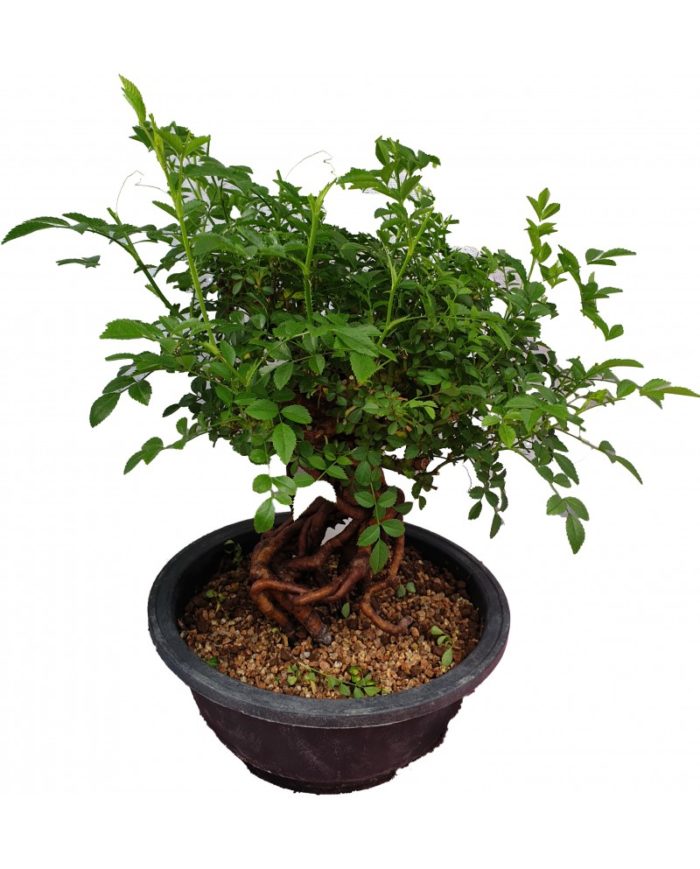

Larch
European larch in nature rises 40 m above the ground. But it can also be grown as an exhibit in the collection of miniatures. The plant attracts art lovers with its beautiful, loose crown, which spreads widely thanks to horizontally growing branches. Leaf plates replace needles, which turn yellow and fall off in autumn. In a pot, the plant reaches a size of 1.5–2 m.


Rowan tree
You can also try to create bonsai from this garden culture. To do this, take undersized varieties. However, it should be borne in mind that rowan has a rather large leaf. Therefore, many gardeners are in no hurry to spend energy on it. The miniature is not so small. But if you still want to experiment, then reproduction from seeds is one of the most successful methods. Since the cuttings are rooted, it is difficult.
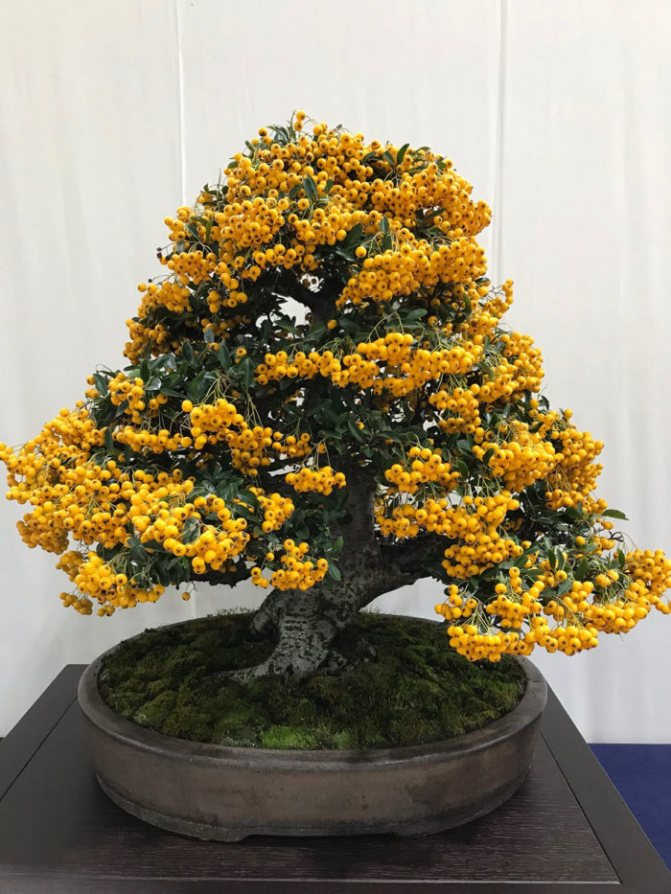

Juniper
To obtain bonsai, varieties with a compact crown are chosen. The branches and trunk must be flexible. It is good if the juniper gives a lot of foliage - this has a positive effect on decorativeness. Better than others, the Cossack variety is reincarnated. It's good even for beginners.
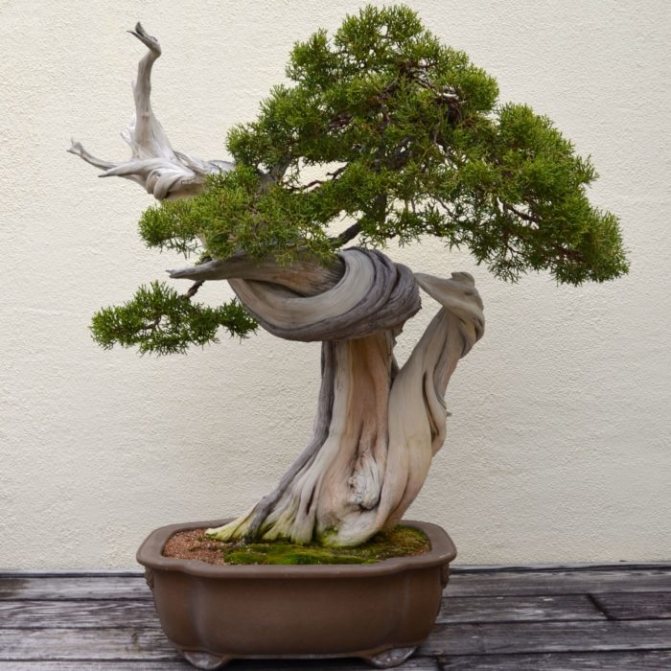

You can also pay attention to the following types of shrubs:
- scaly;
- ordinary;
- rocky;
- Virginia.
Growing by grafting
This breeding option is carried out in early May. Cherry, cherry and plum seedlings are great for rootstock material.
People's hobbies sometimes take on bizarre forms. Extremely popular today. This is the name of the ancient Japanese art of growing a tree in miniature. Sakura, a Japanese cherry that has amazing flowering, is particularly striking. So, we will talk about how to grow bonsai from sakura seeds.
Bonsai Japanese Sakura - seed preparation
The purchased seeds must be stratified, that is, placed in a place for several months in a place (for example, a refrigerator) where the temperature is kept within + 4 + 5 degrees. Before planting, the planting material must be immersed in warm water (up to 35 degrees) for a day.
How to plant sakura bonsai?
Before planting sakura seeds, you need to achieve their germination by placing them in wet vermiculite or sphagnum moss. For planting, they use not a deep container, but a bowl up to 10 cm high. You can plant several seedlings in one bowl at a distance of at least 10 cm. Suitable land is a mixture of sand, peat and humus garden soil. If the seedling has long roots, they can be carefully trimmed with garden shears. After planting, the seedling is watered.
Sakura bonsai - cultivation
The main difficulties in growing this cute tree are holding back growth and giving the characteristic shape of the branches and trunk. This can be achieved if, for example, pruning roots or shoots, using scarce soil, fertilizing with a minimum concentration of necessary substances.
Another way to form sakura bonsai is to make horizontal cuts along the trunk with a sharp knife. The sap released will significantly weaken the tree and prevent it from reaching the peaks. It is also possible to use a wire tie on the barrel. When the tree reaches a height of 25-30 cm, we recommend removing the top so that the growth moves into the side branches.
Caring for bonsai sakura also involves the formation of a crown. If you want the branches to take a certain shape or bend, you need to use a wire. With its help, the branches are wrapped and bent, giving the direction of growth. In this case, it is important to unwind the wire from time to time so that it does not finally grow into the branch. In addition, shoots and branches are pinched from time to time for density. By the way, pruning is carried out before the start of sap flow.
Please note that sakura loves bright lighting, so it needs additional lighting during the cold season. She also responds well to feeding. In the spring, ammonium nitrate is used, in the fall, potassium sulfide, etc.
Bonsai from cuttings
If you compare this method with growing from seed, you can find out that growing bonsai will be one year faster. Another advantage is the previously known characteristics of the plant. They correspond to the mother tree. Start by choosing suitable cuttings. It is required to cut a shoot in the spring, the length of which is from 5 to 10 cm, the thickness is from 0.2 to 0.5 cm. Lignified branches are planted in summer.
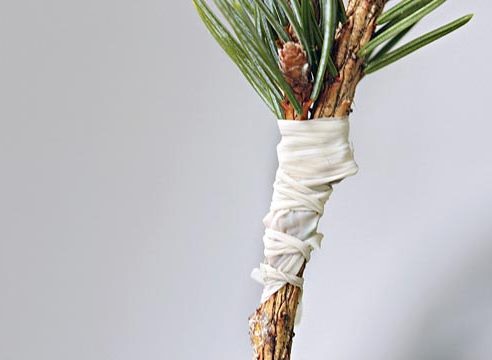

In order to get bonsai by cuttings, it is required to root the shoots correctly. The container must be washed and disinfected. A drainage layer is poured at the bottom, and a soil mixture with nutritious properties on top. From below, cuttings are cut at an angle of 45 degrees. Pinch the top. It is important that the plant forms roots and does not nourish the green mass.
The shoots are buried 2 cm and watered abundantly. If crops grow in high humidity, you need to create greenhouse conditions with a jar or bag.
The substrate is kept moist at all times. Regular ventilation of the greenhouse is required. The shelter is then removed. When a young leaf appears. This indicates that the plant has taken root. Formation begins only after a few years.
Store seeds or plant immediately
The seeds of various plants may differ from each other not only in appearance and weight, but also in the type of seed box. In addition, for each individual variety, there is a specific seeding method that will allow the seeds to germinate correctly.
Seeds of spruce, pine, beech, oak, euonymus and fir are ready for sowing at the time of harvest. If they need to be planted at another moment, then the seeds can always be saved by placing them in a cool place, after wrapping them or placing them in a container.
The seeds of other plants, such as hawthorn, juniper, maple, hornbeam, quince, require some period of dormancy and stratification. They must be kept in a cool place, previously placed in wet sand. The period of this such rest can have different periods, from six months to a year.
Growing features
Literally translated "bonsai" means "grown on a tray." This does not belong to technology, because the bonsai technique is a real art. It is not enough to grow a tree in a pot, you still need to preserve all its proportions and natural forms.


Bonsai-style sakura is grown in compliance with the following requirements:
- the trunk should be strong, the roots at its base should be clearly defined;
- all branches should have a clear, graphic outline;
- the tree retains all the characteristics of the species and genus;
- pay special attention to the pot - it should not attract attention to itself by excessive color brightness, unusual shape, etc.;
- the tree and the pot are a single compositional whole.
In addition to compliance with the requirements, cultivation features are added that cannot be ignored:
- A strong trunk is laid in the first two years, so the pot is selected a little more than for ordinary plants.
- Every year in the spring, a transplant is required, during which the roots are "revised", the extra ones are cut out.
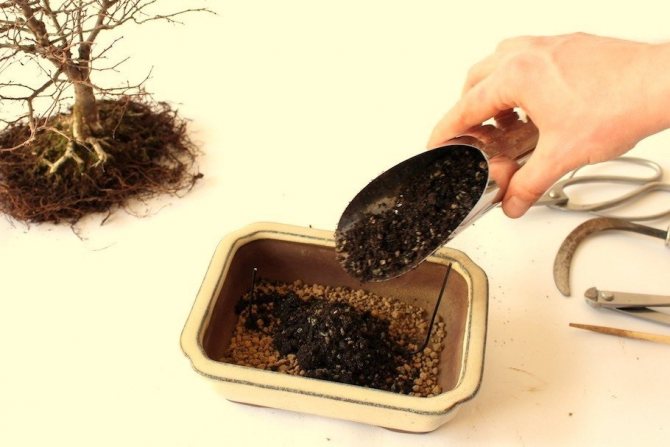

In general, caring for sakura bonsai requires more time than for an ordinary houseplant - constant compliance with the conditions of detention (temperature, humidity), giving the tree the desired shape and other nuances, which we will discuss below.
Planting seeds, soil composition
The soil can be fertilized with reagents, take garden or inorganic soil. The technique used depends on the culture you choose. For bonsai, you need a light soil that will allow water and air to pass through. To do this, drainage is added to the soil mixture - coke, pottery shards, coarse sand, bark and gravel.
Akadama is used to grow such plants. It is a substrate that contains different types of clay. You need to prepare the components. They are obligatory disinfected with potassium permanganate, boiling water. You will also need to bake in the oven.In conditions at home, the composition of the soil mixture corresponds to the following types:
- Sod, vermicompost and sand in a ratio of 7: 1: 3. For flowering crops.
- Sod land and sand 7: 3 - deciduous trees.
- Sod and sand 3: 2 - conifers.
For bonsai, take a shallow, small container. Mandatory drainage holes and expanded clay or pebbles at the bottom are required. For good moisture and air permeability, not only special soil is required. There must be a drain in the container itself. If the plant is mature, a heavier container is required.
Initially, planting material and a suitable culture are selected. The tree is obtained from ready-made seedlings, cuttings and seeds. These methods have certain pros and cons. It is necessary to follow the steps step by step. You can not skip anything, as well as delay the implementation of certain procedures. It may seem that growing bonsai at home is difficult.
The thing is that the crown must be formed in a timely manner. Large plants grown in the forest are not suitable. Small seedlings are much easier to shape. The ideal solution is to grow bonsai from seed. It is possible to keep the process under control. For a successful result, you need to choose the optimal culture. At the same time, one cannot deviate from the desired style.
Prepared seeds are planted in spring, late summer or even fall. Peat cups or pots pre-filled with a mixture of sand and peat in proportions of 1: 1 are perfect for planting. You can replace this composition with soil for cacti purchased in the store, to which coarse sand should be added.
The soil mixture should not fill the container to the brim, it is required to leave about three centimeters to the top. Next, 1 centimeter of prepared, but already sieved soil. Further, the soil requires a little pressure with a piece of wood and lay out the seeds. They are sprinkled with sand on top. The thickness of the last layer should be a maximum of two diameters of the seed to be planted. Press down again with a piece of wood and pour a little water over it.
The seating container is covered with polyethylene or glass to create a greenhouse effect, and placed in a place away from sunlight and high temperatures, which should not be more than 15 degrees Celsius.
The soil in the container should be constantly moist, not dry out or flooded with water.
Where to get bonsai seeds, germination and care
How to germinate the seeds of a bonsai tree needs to be figured out in detail. Don't rush to root them in purchased or hand-made substrate right away. First of all, it is recommended to carefully prepare the planting material, process it and only then germinate. You need to start such events well in advance.
Before planting seed, you should place it in a humid microclimate. This is necessary, since the shell of such grains is rather dense and therefore does not absorb water well. All you need to do is fill the container with the first layer of wet sand, spread the seeds on top of it, and then cover with a second layer of wet sand. Be sure to cover the pot with plastic wrap and then place it in a cool, dark place for about three months.
When you plan to plant the seeds, take them out of the shelter, then place them in warm water for 2-3 days. It is also advisable to carry out heat treatment: heat the seed in a water bath or freeze it. It is not difficult to germinate the seeds correctly, the main thing is to adhere to the key recommendations from specialists. In this case, you can count on a full-fledged result.
In order for the seeds to be ready for planting, they must be properly germinated and treated with drugs, otherwise problems such as the death of the seed due to certain diseases are possible. Before planting, the seeds are placed in water for several days to swell and begin the process of primary germination. It is also possible to germinate seeds in sphagnum moss or vermiculite.
It is better to plant bonsai from trees of your climatic latitude in autumn; exotic specimens must first be stratified.
Stratification is the process of hardening seeds, a special treatment close to the conditions of the cold season.
- Qualitative characteristics of seed material. This includes collection, storage, aging.
- Temperature regime for germination.
A good seed for a bonsai composition would be the seeds of the current season. This is very important, especially for trees whose seeds quickly lose their germination.
The choice of capacity and soil for sowing
To grow decorative sakura, first disposable containers for germinating seeds are needed, and then bonsays, special shallow flat pots that do not allow the root system to grow too much, no more than 20 cm in diameter. peroxide in 250 ml of boiled cooled water).
Disposable containers for germinating seeds and forcing sprouts:
- initially, wide, shallow plastic containers with drainage holes. It is enough to rinse them with clean water. Since the roots of sakura are fibrous in the early stages of development, the germination container should be 5-10 cm deep;
- after diving - small, literally 100 ml plastic cups with mandatory holes to drain excess water.
Sakura seedlings are demanding on the soil, which must be sufficiently saturated with potassium and nitrogen. For successful germination, it is advisable to acquire the soil substrate from vermiculite (or sphagnum) and coarse-grain sand. For forcing shoots, it is permissible to use one sand. In any case, it must first be disinfected with potassium permanganate and calcined or steamed.
Substrate after diving: Mix 1 part of humus and 7 parts of turf soil with sand (3 parts).
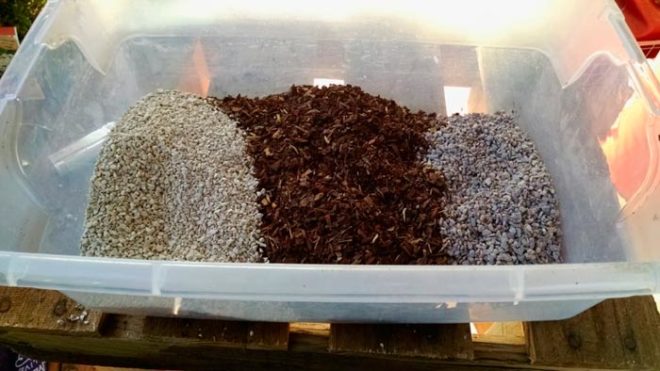

Seed preparation and sowing
Sakura bonsai seeds are planted in spring or late August and early September.Quality seed is one of the main ingredients for success. The seeds are sold in specialized stores. You can order them directly from the manufacturer by mail.
Seed germination is low - up to 20% (to grow two sprouts, you need to plant ten pieces). Therefore it follows:
- buy and plant more material;
- purchase products from different manufacturers in order to identify those who have better quality products.
Seed preparation begins long before sowing and includes:
- careful examination of each and removal of spoiled, with a broken outer shell;
- scarification or stabbing, scratching of the outer shell. This will help the seedlings break through faster;
- soaking in water at room temperature (or slightly warmer) for a day. Manganese can be added (until a slightly pink liquid or suitable fungicide). Instances that have surfaced are removed - they are guaranteed not to ascend.
The substrate is moistened and the seeds are deepened into it by 0.5-2 cm into the grooves. In the row between future seedlings and grooves, there should remain:
- not less than 3 cm - between small seeds;
- not less than 5-7 cm - between large ones.
The plantings are covered with a small layer of fine-grained sand and cover the container with transparent cellophane or glass.
It is not enough to plant the seeds correctly, it is necessary to carry out a stratification process - to create conditions for them, similar to winter ones, by placing them in the refrigerator. There, on the lower shelf, at a temperature of + 4-5 ° C, future cherry blossoms are hardened for at least 2 months. After that, the seed is germinated under normal conditions, gradually raising the temperature to room level and keeping an eye on good illumination and sufficient soil moisture.
Some growers stratify the seeds before planting by placing them in a bag with moistened sand and keeping them in the refrigerator for two months. And only after that scarification and landing are carried out.
If all the noted conditions are met, the seedlings appear 10-15 days after being removed from the refrigerator.
It should be noted: during germination, young sakura sprouts use nutrient reserves from the seed cotyledons, so they do not need additional feeding. Moreover, the introduction of any fertilizers can provoke the development of fungal diseases or a delay in plant development due to oversaturation of the soil with organic matter.
Seedling care and picking
The technology of growing miniature sakura requires several picks after germination. They are seated with simultaneous pinching of the root. If the first dive is also carried out in a single container, a minimum of 10 cm is left between the shoots. The composition of the substrate used after the dive is given above. During the first procedure, the root is shortened by a third, stimulating the development of lateral branches.
Origin and botanical description of the plant
In the wild, Japanese cedar is a tree of impressive size, the trunk of which reaches 2 m in diameter. This is the size of a coniferous plant at the age of 150 years. The pyramidal crown and straight cylindrical trunk of this enchanting plant attract attention. Needles on the branches stand out with a dark green tint, even give off blue, cover the shoots in a spiral. Single spherical cones are brownish in color, appear already in the first year, they are up to 3 cm in diameter.
This culture belongs to the Cypress family, the people know the plant as Japanese cedar. The ephedra earned this name due to its gigantic size and majestic strict appearance. Its homeland is Japan and China, so the plant grows well in the humid subtropical climate of the East. Cryptomeria is found both in forests and in alleys, reaching serious heights and widths.
Thanks to the painstaking work of scientists, indoor varieties of cryptomeria (bonsai) were bred, and options for growing in pots, in personal plots, in gardens, greenhouses, parks.
Popular types of trees for growing
There are several trees that have gained particular popularity among gardeners and florists. Most often, the following types of trees are used for growing in miniature:
In fact, this is far from the entire list of trees that can be grown. Oak has become very popular, but its cultivation takes a lot of time and effort.
Planting seeds - terms and rules


The planting of seeds must be selected for a certain period of time, because the development of seeds has a certain cycle. The optimal time is spring, as well as late summer or early autumn. During this time, the seeds are active and can provide good results.
Here are some practical tips that you can apply right away:
Following the established rules for working with sakura seeds allows you to get excellent and healthier plants. Proper care during the germination stage determines the quality of the plant in the long term.
Subtleties of care
Bonsai sakura is capricious, like a small child, she needs daily care:
- Watering - half a glass (100 ml) of water daily in summer, in winter after 2-3 days, the need for the procedure is assessed by the state of the soil.
- Good bright lighting.
- Regular ventilation of the room, drafts are unacceptable.
- The transplant is carried out annually in the spring, as soon as the tree begins to wake up after winter. The optimal diameter of pots for bonsai sakura is 20 cm, this tree is quite enough. However, its roots grow throughout life, so they are pruned every time they are transplanted, this measure slows down the growth of cherry blossoms in height.
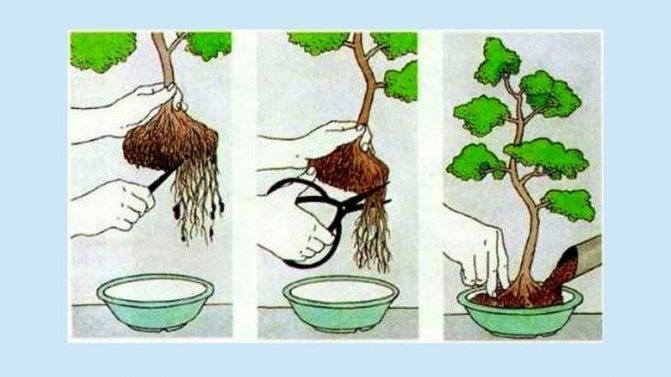

Since the sakura bonsai tree is in a limited volume, it is fed every 20-30 days, depending on the growing season - more often in summer, once a month in winter. Trees over 12 years old are fed monthly. In the spring, the plant needs more nitrogen, a fertilizer with a ratio of N-P-K 12-6-6 is selected for it. For summer, nitroammophoska (10-10-10) is suitable. In winter, the main elements should be in the proportion of 3-10-10.
During the period of bud formation in the plant and during flowering, complexes with a higher potassium content (6-6-12) are selected.
Necessary tools for the job
Pruning is the main technique for forming a dwarf tree. The success of the bonsai technique depends on the quality of the wood cuts. Therefore, you need to prepare the necessary tools. Some hobby gardeners consider buying special tools a waste. However, the use of tools specially designed for the bonsai technique will greatly facilitate the care of the plant and reduce the risk of its death to a minimum.
The basic toolkit includes the following:
- concave wire cutters;
- wire cutters;
- convex spherical pliers;
- scissors.
Concave cutters are designed to cut branches flush with the trunk to form an oblong indentation.The wound received by the plant will heal quickly with a small scar. It is impossible to replace this tool with any other tools at hand. When planning to grow a tree using the bonsai technique, you should purchase concave cutters in advance.
The wire cutters cut the bonsai wire neatly and symmetrically. Their rounded head does not hurt the tree when cutting the wire.
Convex spherical cutting pliers are used to remove growths on trunks and roots, as well as unwanted roots. The cavity remaining after them is quickly tightened with a minimum amount of scarring.
An additional toolkit that will make caring for your plant an enjoyable experience includes the following tools:
- nippers and root hooks;
- root ball knife;
- small Japanese saw;
- thinning scissors;
- tweezers with a curved nose.
It is also advisable to buy soil scoops, rakes and hemp brooms.
It is convenient to cut the roots with root clippers during grafting and transplanting. The roots are untangled with the hooks. A root ball is processed with a knife, large roots and small trunks are cut off. The branches are notched with a Japanese saw. Use tweezers to remove unwanted buds, excess pine needles, dry leaves and insects.
For the bonsai technique, many more tools have been developed for filigree processing of trees, but for a novice bonsaiist, it is enough to purchase a basic set.
Seed selection
Of course, you can use ready-made seedlings - it will be easier. But this is not the way of a real samurai ... It will only be half your bonsai. So let's start with the seeds. When choosing them, the main criterion is your taste and capabilities. Bonsai can be grown from both deciduous trees and conifers and even shrubs. However, the choice of seeds is very important not only for your future aesthetic pleasure from admiring the miniature tree, but also for the work with the plant itself. Different trees require different conditions - some are more thermophilic, moisture-loving or cold-resistant, some less. Before you start growing bonsai, you need to know everything about the selected tree. It should be remembered that tropical plants in our latitudes are more difficult to grow, so think about whether you can arrange for them the conditions of their homeland? Also, do not forget that most of the trees in our latitudes require "wintering", if you are going to grow bonsai in an apartment and you do not have a place in which it is cold enough in winter, then you should forget about growing such trees. And in general, for a start, you should take a tree in an easier way, for example, the Chinese Elm, a small-leaved tree, is not whimsical enough and is excellent for indoor cultivation.
Growing trees from seedlings
How to grow bonsai from seedlings? When the sprouts reach a height of 4-7 cm, we plant them in wide bowls filled with a mixture of peat, sand and humus garden soil. Plant roots that are too long should be shortened slightly with garden shears. The planting material must be deepened into the soil up to the first pair of leaves.
As the seedlings grow, they need to be dived repeatedly. Diving is called transplanting plants into individual containers in order to expand the area and improve root nutrition. Thanks to multiple transplants, a powerful, well-developed root system of young trees is formed.
For the winter, bonsai seedlings are placed in a cool place or left in room conditions on a cold windowsill behind a thick curtain. The plant is not touched until spring. The dive continues in the spring. It will take 2-3 years to grow sakura. Only then will it be possible to start forming a tree at home.
The rules for forming a crown are as follows:
- 1The task of the bonsaist is to constantly restrain the growth of the tree and give it its characteristic dwarf shape.
- 2 The trunk at the base of the tree should be thick. To achieve this effect, all vertical shoots are cut.
- A bonsai plant should look like a century old tree, even if it's only 3 years old. To give the tree its characteristic appearance, the upper part of the roots is exposed. For this, the top layer of soil is removed.
- 4 At what level to start forming the crown, the bonsaist decides, cutting off the lower branches. The first strong branch of the trunk will be the lowest one, not cut by the bonsaist.
- 5 Barrel that is too long must be shortened. To do this, a circular strip of bark is cut off at the base and the tree is transplanted, immersing the bare spot in the ground. At this point, roots later grow. The old roots are cut off and the plant is replanted.
- 6 If the broom style is selected, the vertical branches are trimmed as much as possible, allowing the horizontal shoots to bush. If the vertical style is chosen, the main trunk and side branches are encouraged to grow upward.
- 7A already formed bonsai tree needs to be pruned and pinched constantly to maintain its ideal shape.
Bonsai museums in Japan
In Japan, bonsai is not just a form of national art, aesthetics and worldview. Japanese achievements in the art of bonsai have already become part of museum culture. The Omiya Bonsai Art Museum was opened in spring 2010. The museum promotes bonsai art both within the country and outside Japan through exhibitions and various information events.


Bonsai is a form of traditional Japanese culture in which a person has to plant a tree in a pot and shape its branches, leaves and trunk.
Museums say that bonsai have been known since the 9th century. In order to grow a tree in miniature, it must be carefully trimmed and the branches shaped by twisting them with wire. Trees live and grow, so work on bonsai never stops, they require constant care, fertilization and watering.
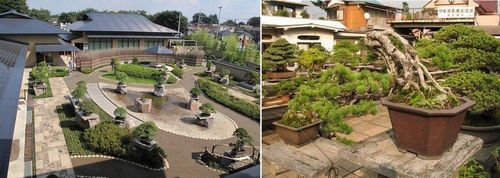

Omiya Bonsai Museums Showcase Bonsai Photos, Paintings and Installations
Masterpieces such as Goyo Matsu (Japanese white pine) are valued at over 100 million yen. Nowadays, bonsai are well known outside of Japan, many tourists from all over the world visit Japanese bonsai museums.
The museum is located next to "Bonsai-mura (bonsai village)", where many manufacturers and fans of bonsai live and create. Around Bonsai-mura there are 10 bonsai gardens, which are an excellent display. The village is planted with trees such as maple, keyyaki and cherry trees. Visitors can enjoy the atmosphere of all seasons by contemplating the growth and maintenance of trees. Japanese museums are a favorite meeting place for bonsai lovers around the world.
Bonsai Museum (video)
Preparatory stage
First of all, you need to stock up, as already noted, with patience. It will take at least ten years to grow sakura bonsai from seeds and get an amazing miniature tree.
Japanese sakura easily tolerates air pollution above normal, but requires regular (daily) watering, as well as good lighting. Since the cultivation process is long, you should take care of a good place for it in advance and delegate watering responsibilities in the absence of the gardener himself. It is also necessary to protect the flower from direct sunlight and drafts.
Not all varieties of Japanese cherry blossoms are suitable for home cultivation. Amanogawa can be germinated from the seeds at home. Shirofugen. Tai. Shirotae.
What is bonsai
When everything seems to be planted in the garden, then you want something unusual and new. Bonsai are the same trees that everyone knows, only in a miniature version. You can grow bonsai from seeds from any tree, you just need to know what and where to buy seeds.
The growing process is quite lengthy and painstaking. It takes about 5-6 years to get the desired result. Not every grower will reach the final, but, nevertheless, the grown tree is very decorative and effective, and, of course, will become a favorite at home.
Popular trees are bonsai trees that can be grown by seed
To make a choice, you need to figure out which plants are the most famous. There are tropical, deciduous and coniferous trees from which bonsai trees can be grown. Today, for example, oak has become fashionable, but it will take a lot of time to grow. Also known are the following:


Here is not the entire list of trees from which it is quite possible to grow bonsai. The art of cultivation came to us from Japan and has become very popular with us, despite the exactingness and capriciousness of miniature plants.
Plant size classification
To choose the right tree, you need to decide not only on the capacity where it will grow, but also on the size, shape, height.
- Miniature. The height ranges from 5 cm to 15 cm. They are very tiny, but they only benefit from it.
- Small (15 - 30 cm).
- Medium (30 - 60 cm).
- Large (60 - 1.2 m).
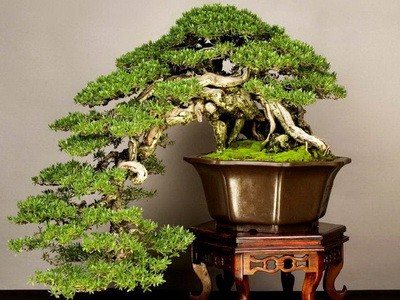

The most popular are the first few groups, because it is the diminutiveness that is appreciated. Such small trees are the highlight of any interior.
Where can I buy seeds?
The seeds can be taken by yourself in the botanical garden or in the park. It is also recommended to buy from specialized gardening stores or order. Seeds for planting are also bought in stores on the Internet, some are purchased on order from China.
Japanese bonsai tree
Similar articles
- Bonsai from beads: a photo of a tree, a master class, do-it-yourself mk, how to make a mini bonsai, a druid, video lessons of beading step by step, crown, video


Beaded bonsai is a great decoration for any interior. Beaded accessories are very popular nowadays. The session may seem long and ... - Japanese curtains: do-it-yourself photo, panels and cornices, stylish kitchen, curtains on the balcony, how to sew, accessories, video


Japanese panels or screen curtains can become an accent in any interior style Japanese ... - Do-it-yourself tree topiary: photo master class, how to make decorative, grape, tangerine, flower crafts, video
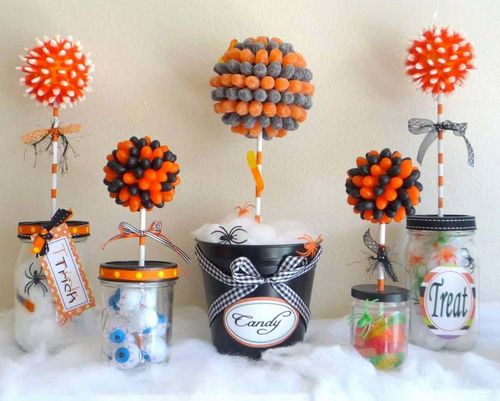

Today, topiary is in great demand among people who want to present an original and beautiful gift, but for this they have time ...
Top dressing and fertilization
In order for the tree to grow and develop well, you should follow the fertilization and fertilization schedule. Flowering plants need phosphorus feeding. It is also important for fruiting plants.
- Dosage: Dissolve 1 g of fertilizer in 1 liter of water, put the pot in the prepared water and leave until the soil is saturated. This way you will not overfeed the bonsai.
- Schedule: potassium is applied in October and November, winter is a break, spring and until July, nitrogen and phosphorus are applied at least once a month. There is a break from July to September.


Fertilizers and fertilizers can be used for indoor plants, universal, but the concentration should be reduced. Some growers purchase special formulations for these plants. It is important to observe the dosage so as not to harm the plant.
An adult plant needs mandatory pruning and crown formation. It takes real skill and taste, but the result will please.
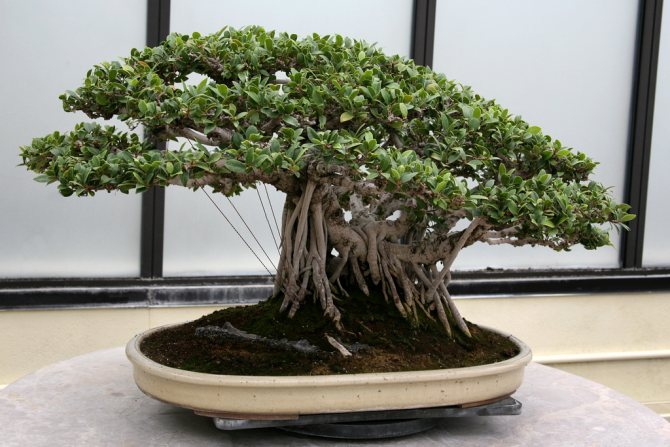

Making miniature copies of trees is really fun. It appeared in China. With the help of wood, you can decorate absolutely any interior. If you wish, you can grow bonsai from its seeds yourself at home. It is only important to choose the right plant. Each species has specific characteristics. But specific care is rarely required.
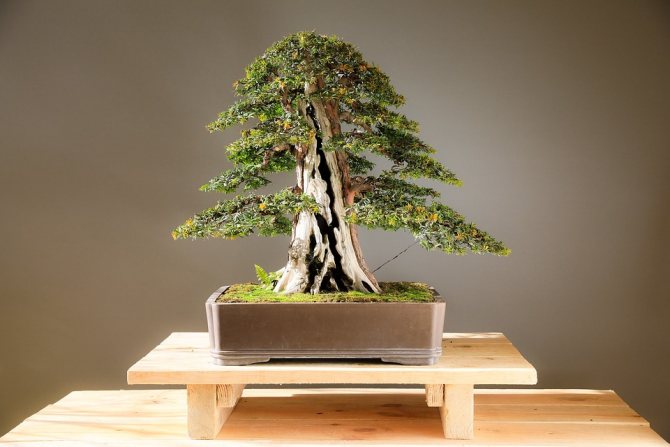

In order to create interior decorations in the current bonsai style, they take species that are not suitable for growing at home. This is why it is important to ensure that the flower has constant access to fresh air. It is also required to create the necessary microclimate. In order to grow a bonsai tree, you need to follow certain agrotechnical recommendations.You also need to take into account the characteristics of the variety and the needs of the plants. Lighting and watering requirements are different. Some crops require a lot of light, others are better protected from direct sunlight.
Bonsai is grown in a small container. If there is more substrate, the root system will grow, long shoots and large leaves will appear. If the plant is not cut, the plant will gradually lose its attractive appearance. Growing a beautiful bonsai requires constant grooming. Requires constant monitoring of the tree. It is important to form the crown in a timely manner and shorten the roots. If the climate is unsuitable or the natural growing cycles are not followed, the plant will be destroyed. It is forbidden to violate the hibernation time of the culture, if it has one.
Features of sowing seeds
The prepared material is best planted in the ground in the summer; they also use the period of late spring or early autumn, when the day is long enough and it is warm outside.
Planting should be carried out in peat pots, which are pre-filled with a mixture of peat and sand.
The narrowed components are mixed one to one, and you get an excellent substrate for seed germination. If it is not possible to find peat, you can purchase soil for planting cacti, but it must be mixed with coarse sand. Further, the basic sequence is observed:
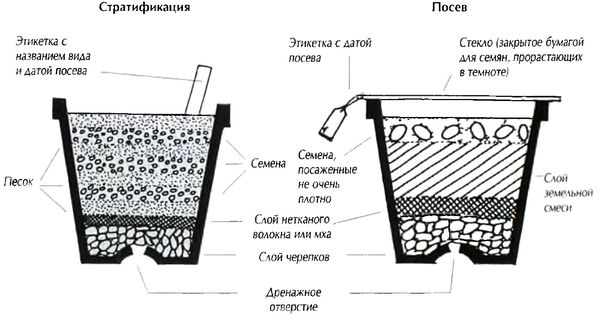

- Soil is poured into the prepared container so that at least three centimeters remain to the edge.
- Sod land is prepared for growing bonsai and poured over the main soil, its thickness is no more than one centimeter.
- Now on this layer, you can lay out the already prepared tree seeds and sprinkle them with sand. The thickness of the sand layer is no more than four centimeters.
- From above, everything is pressed down with a wooden circle or simply tamped tightly. The sand is poured with water, no more than 80 ml of water is poured at a time.
- The pot is covered with cling film or a plastic bag so that the moisture does not evaporate.
- A pot with planted seeds is sent to a dark place, the temperature there should not be higher than 15 degrees.
- The film should sometimes be removed to ventilate the soil, and also check the soil for moisture.
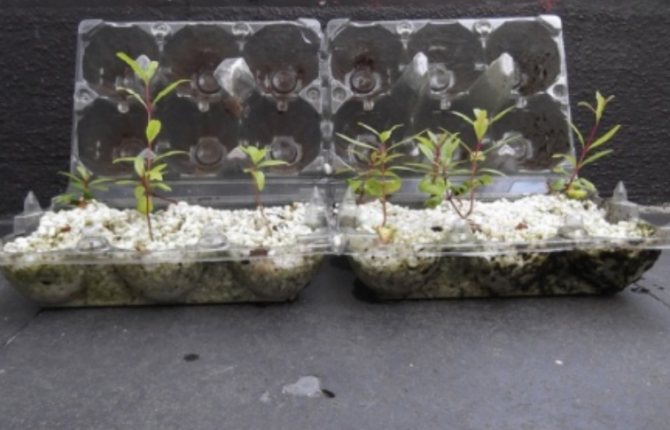

As soon as the first sprouts appear, the plastic film is not removed, but pierced in several places, this will ensure the flow of oxygen to the sprouts. As soon as there are noticeable shoots, the film is completely removed and the pot is removed to a sunny place.
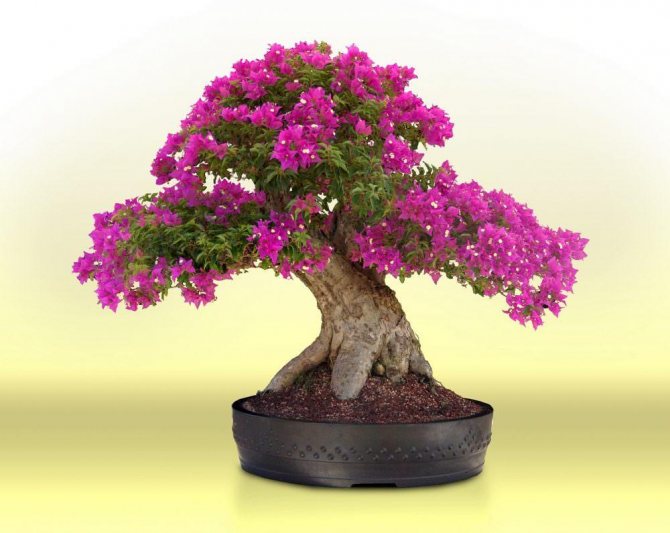

It is very important that the rays of the sun do not fall on young plants, otherwise this can lead to the death of the plant. And after three months, the main root is cut into two-thirds.
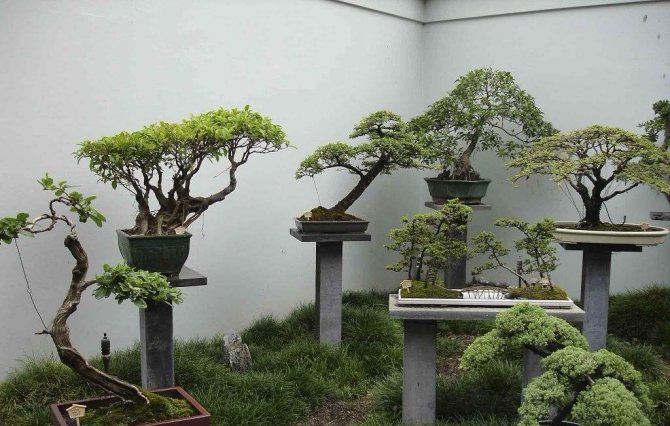

We have talked enough about how to grow bonsai from seeds from China. At home, you should wait until the sprout reaches ten centimeters, and then it is transplanted into a separate pot.
Picking
Plant diving is extremely important for the development of the tree. The first pick should be done immediately after germination. Small shoots are planted in 100 ml cups. The substrate is made up of 7 parts of sod land, 3 parts of sand (disinfection, roasting in the oven is mandatory) and 1 part of humus. During the first pick, the root is shortened by 1/3.
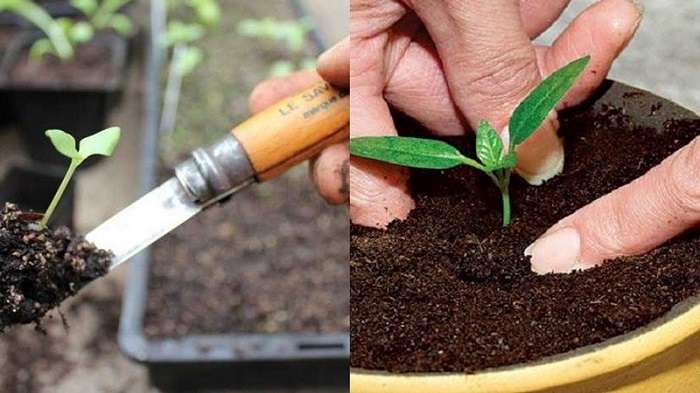

The second picking of plants is carried out after 2 months. During the period of work, the root is pinched by 2/3 and the plant is slightly buried. The soil is used with the same composition.
The third pick is carried out after the sakura grows up. But not more often than 2 months after the second procedure. It is recommended to repot the plant when the plant to pot height ratio is 2: 1.
Growing lemon at home
Indoor (dwarf, bonsai) lemon is a perennial evergreen tree with sour fruits from the rue or citrus family. Plant height usually does not exceed 1.5 meters, with the exception of tall varieties.Lemon bears fruit for about 60 years, and the formation of fruits from flowering takes up to 8 months.
The following varieties are ideal for growing a plant on a windowsill:
- "Ponderoza";
- Novogruzinsky;
- "Pavlovsky";
- Meyer.
It is important to remember that lemon cannot tolerate direct sunlight. That is why the best place for him will be the western side of the room. In addition, this tree should not be moved too much. For the uniformity of the crown, it is only slightly turned over (about 2 cm) once a week.
Step-by-step landing instructions:
- A pot for planting must be chosen short and slightly widened. Before work, such a bowl is scalded with boiling water to destroy harmful bacteria.
- At the bottom of the treated pot, it is necessary to lay out the drainage to a height of 2 cm.
- The next layer is 1 cm of fertilizer and the soil mixture is poured.
- We plant the seedling so that the root system is not very deep. It should be at the level of the bowl. If you plan to grow a tree with seeds, then you first need to germinate them in a small pot. For this, the seeds must be thoroughly treated with a manganese solution in advance.
- Sprinkle the seedling with sod, leafy and large-leaved soil, crush it a little and pour it with warm water.
- It is very important to consider the proportion between the soil and each type of soil. It must be absolutely equal (1: 1: 1: 1).
- Tip: it is recommended to keep the lemon in a greenhouse until the seedling is fully rooted. You can easily do it yourself. To do this, cover the pot with the plant with a transparent vessel with small holes (they must be made in advance).
And a little about secrets ...
Especially depressing for me were the eyes, surrounded by large wrinkles plus dark circles and swelling. How to remove wrinkles and bags under the eyes completely? How to deal with swelling and redness? But nothing makes a person look older or younger than his eyes.
But how to rejuvenate them? Plastic surgery? Recognized - at least 5 thousand dollars. Hardware procedures - photorejuvenation, gas-liquid pilling, radiolifting, laser facelift? Slightly more affordable - the course costs 1.5-2 thousand dollars. And when to find all this time? And it's still expensive. Especially now. Therefore, I chose a different way for myself ...

